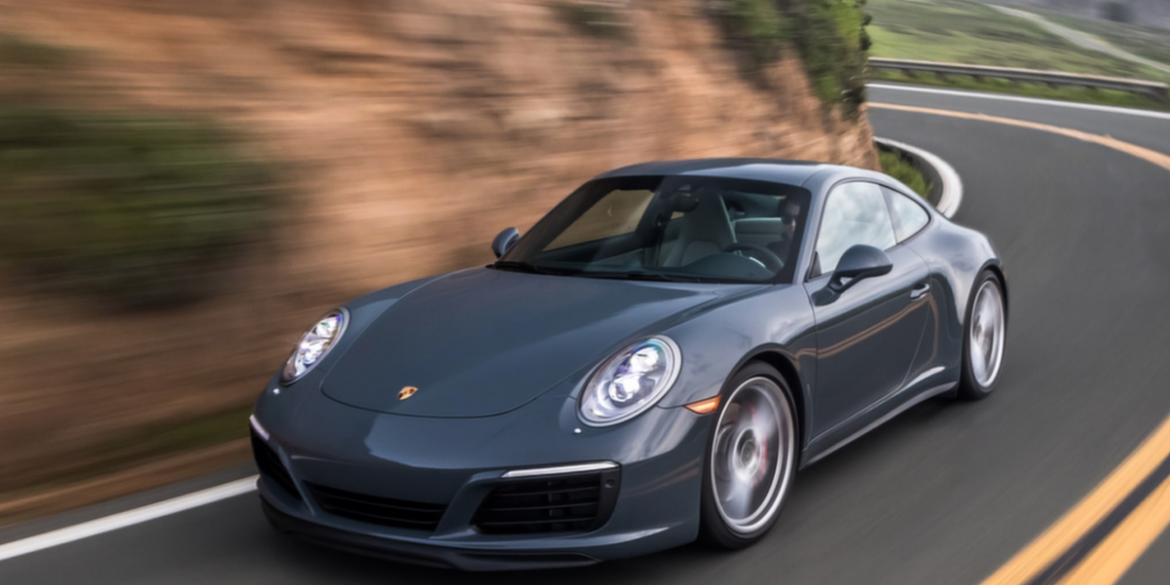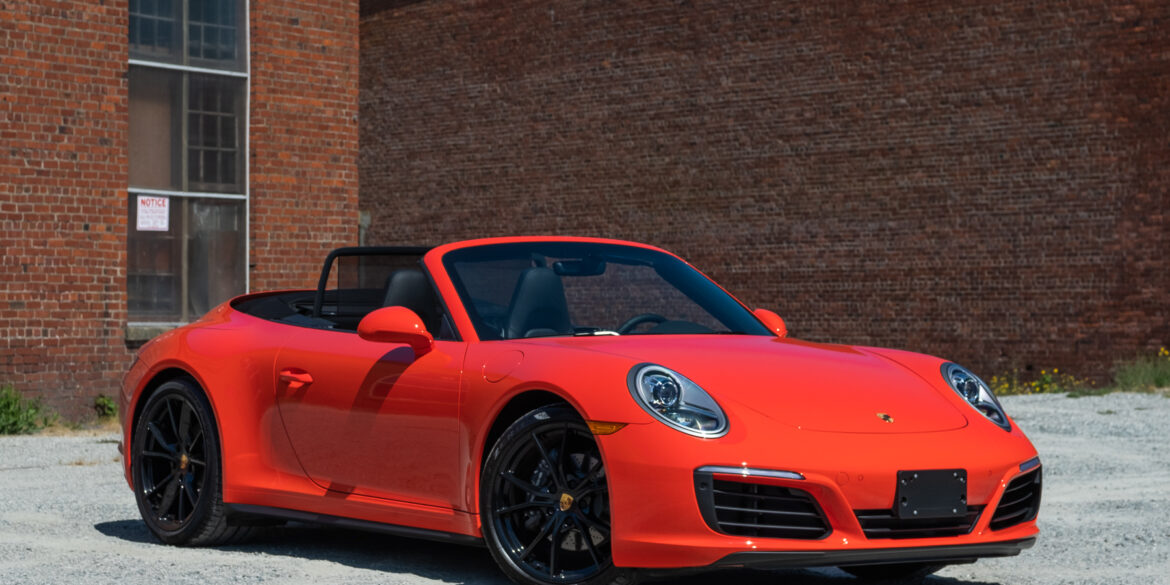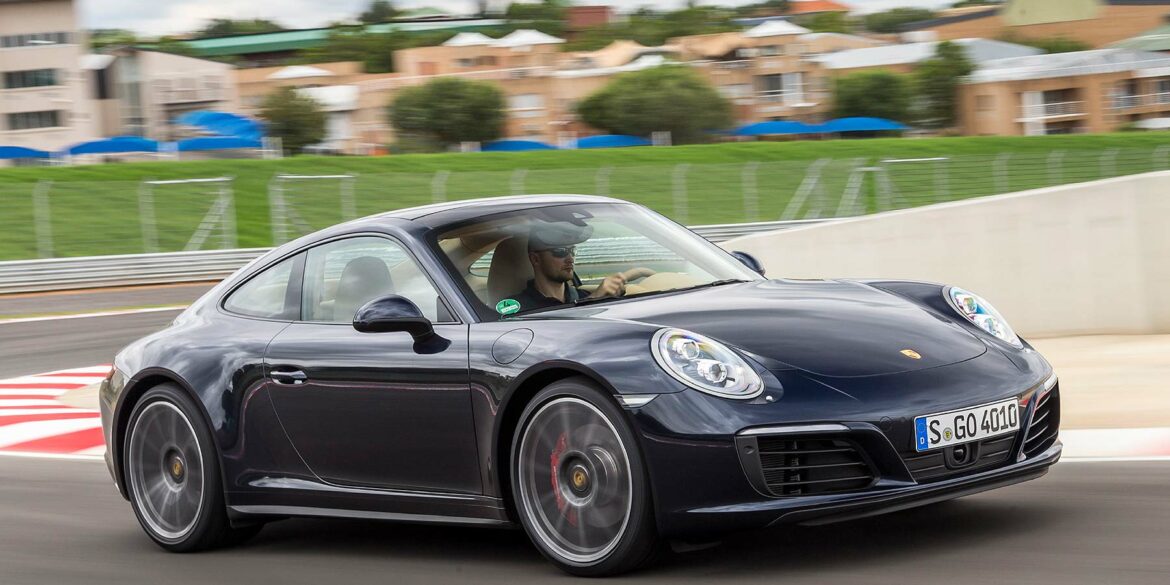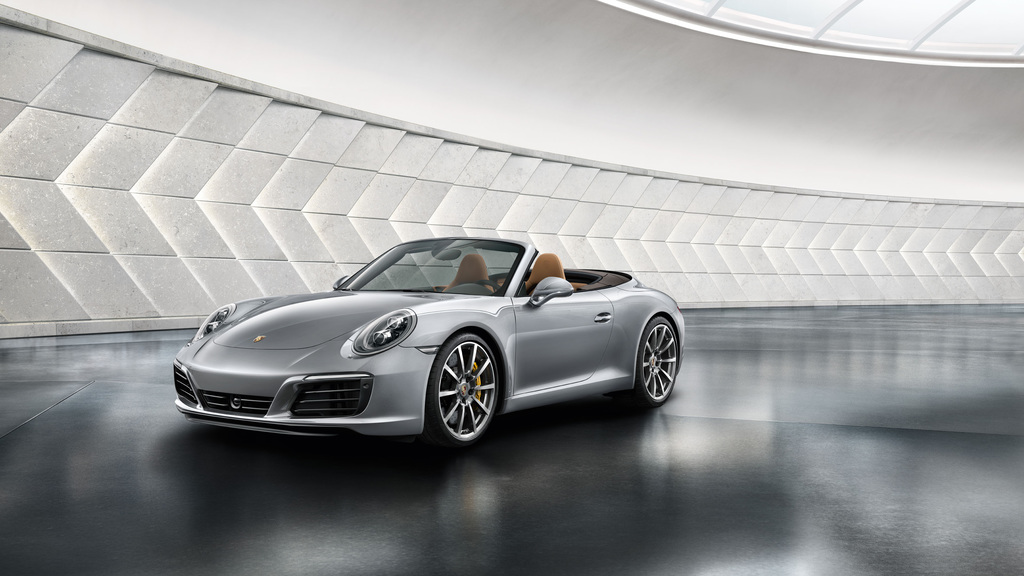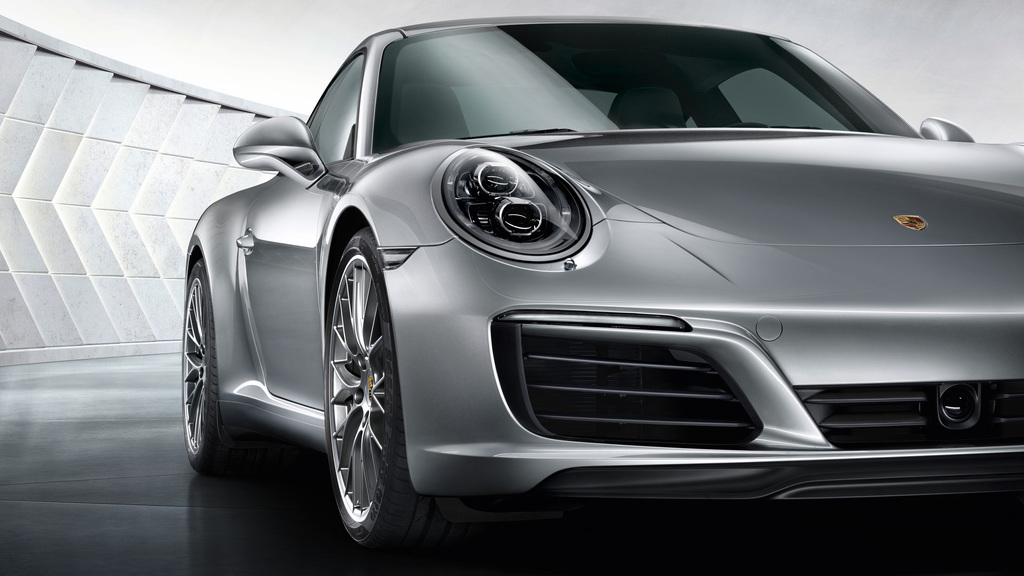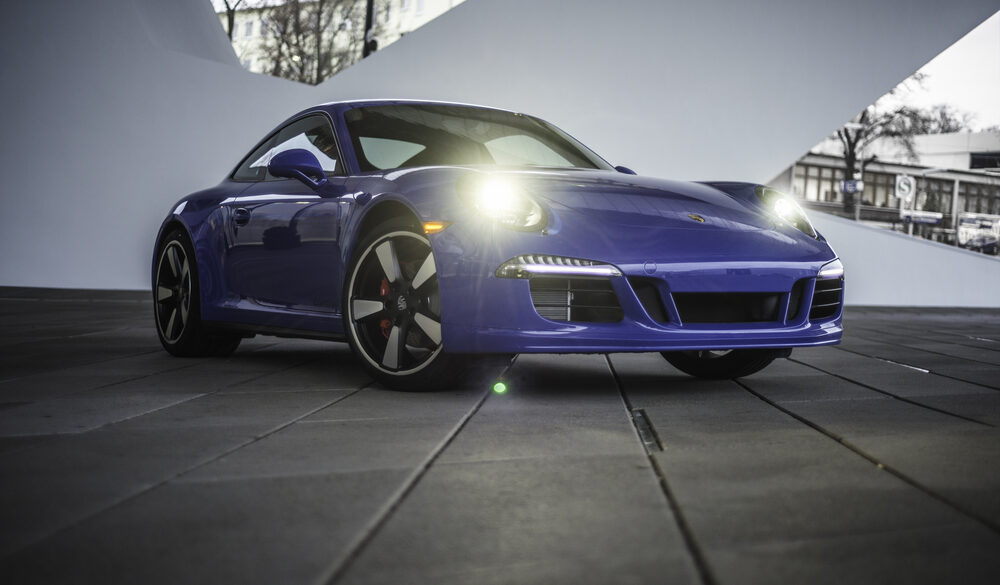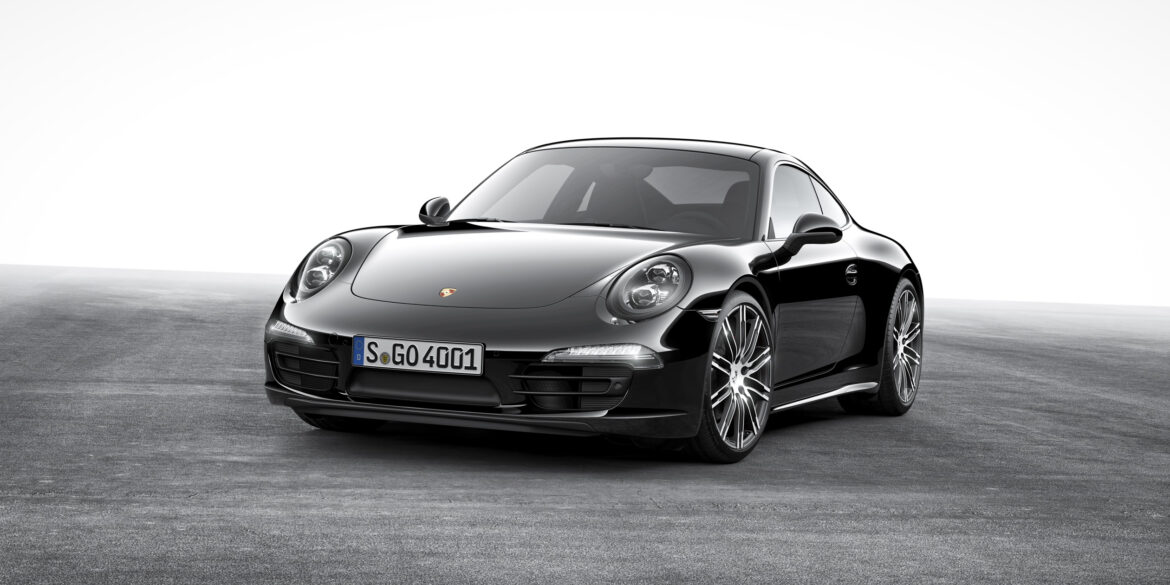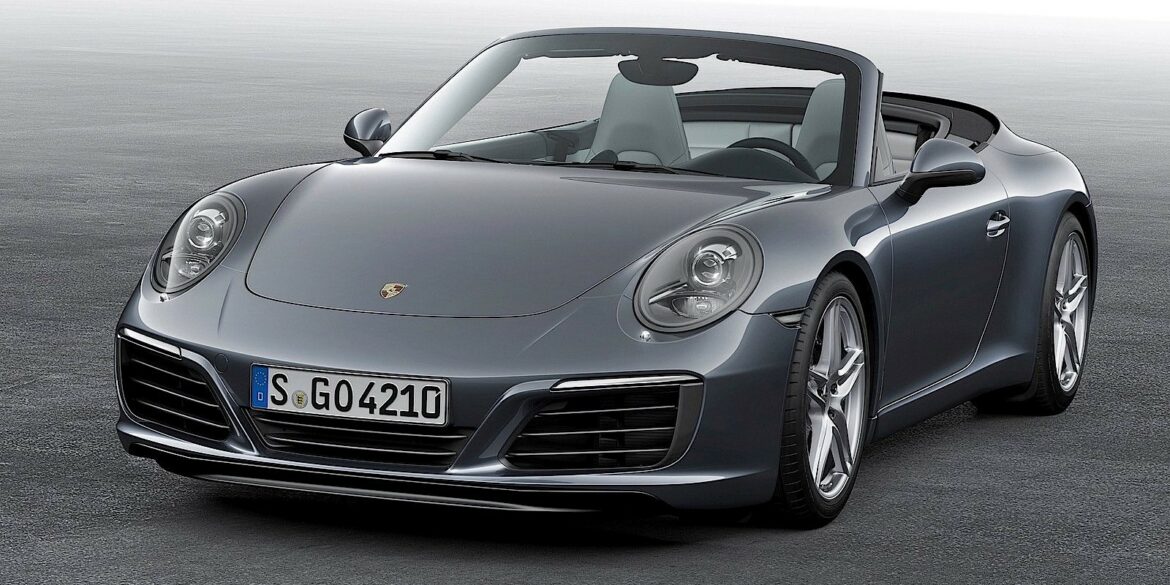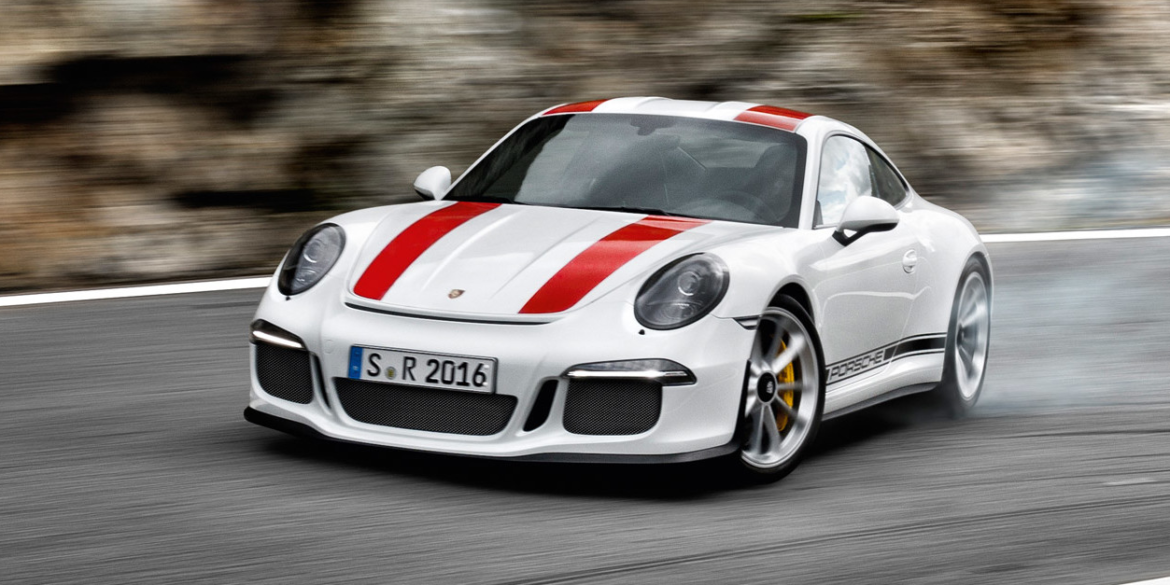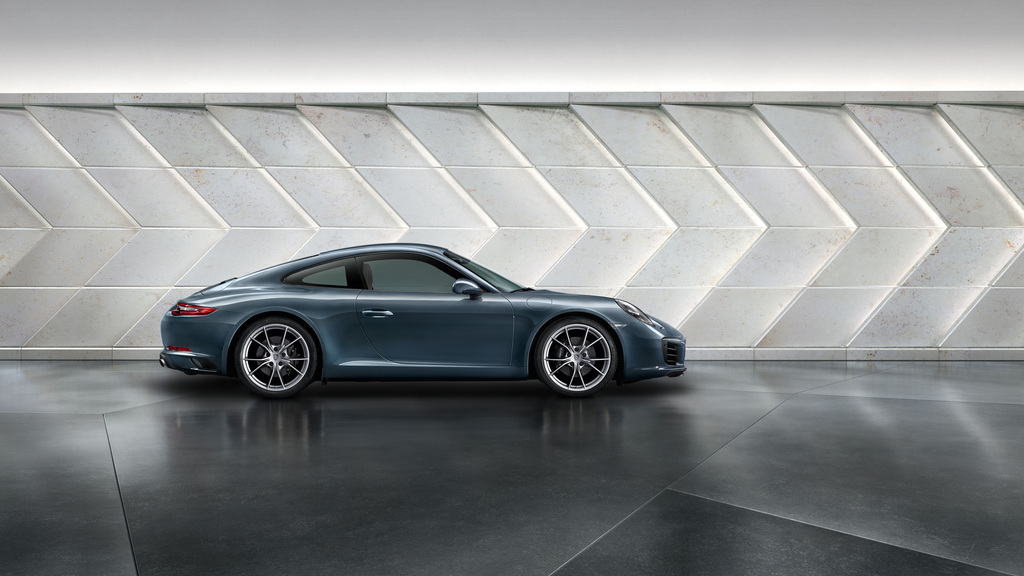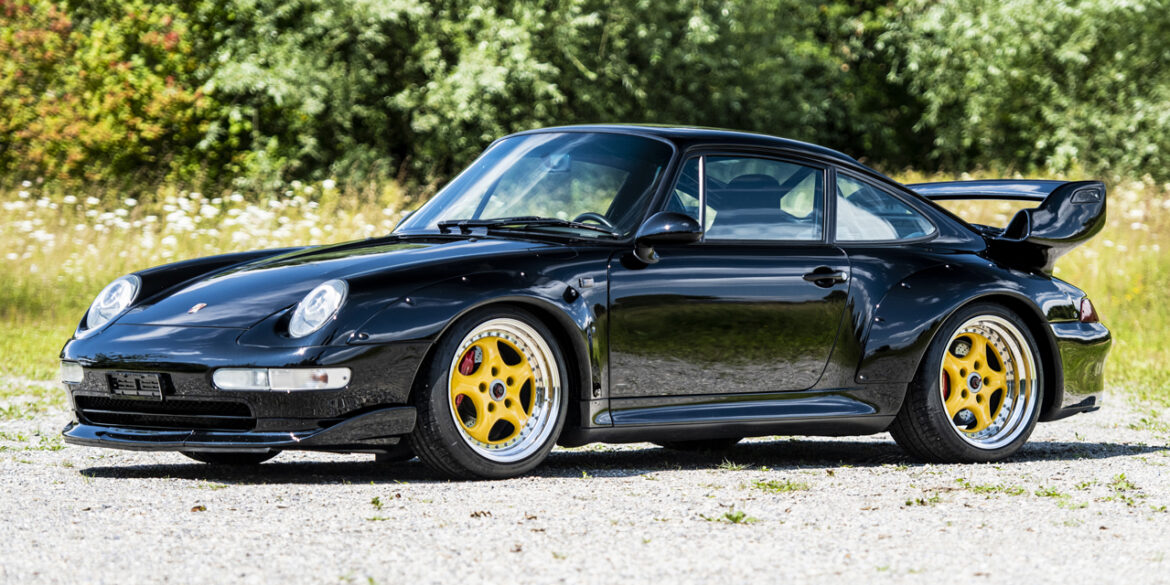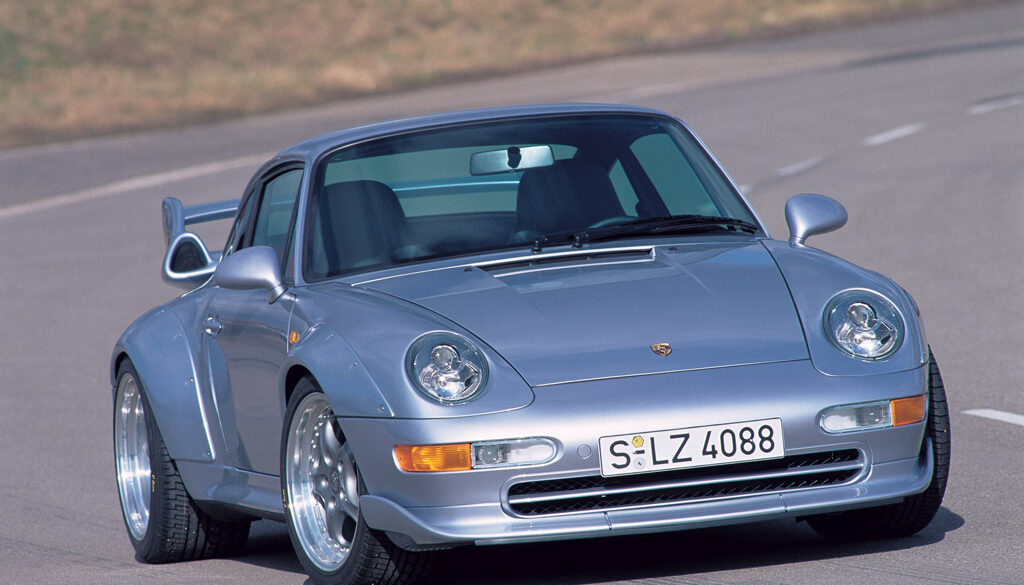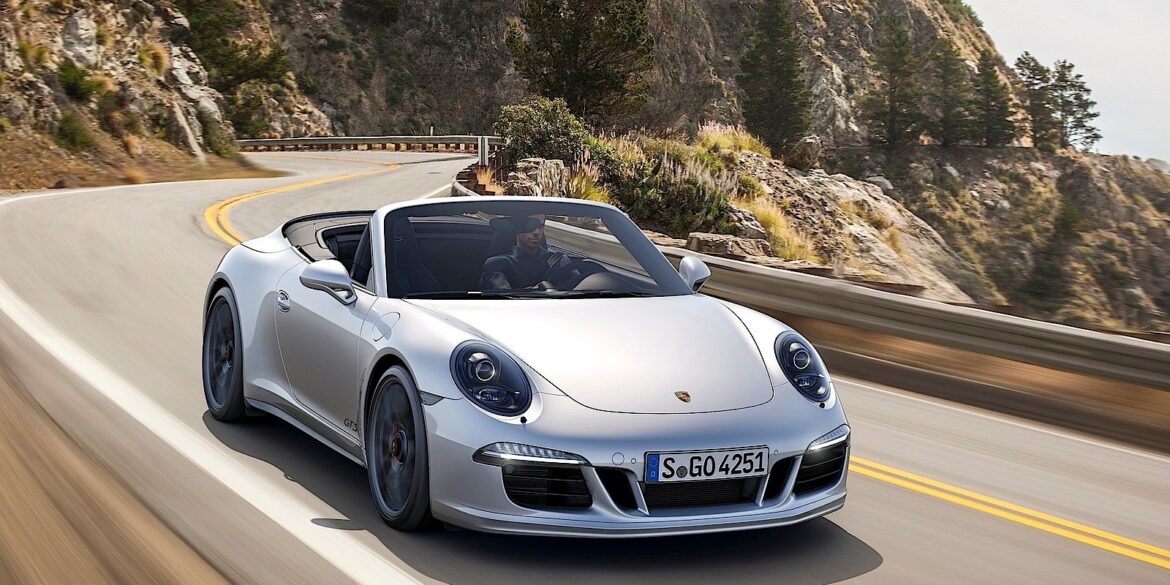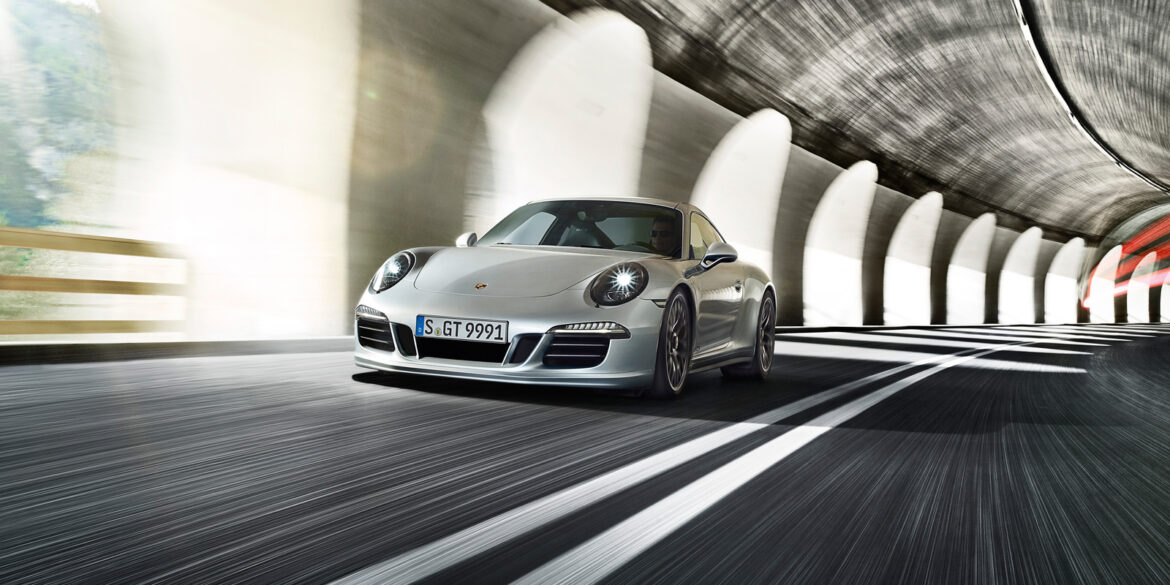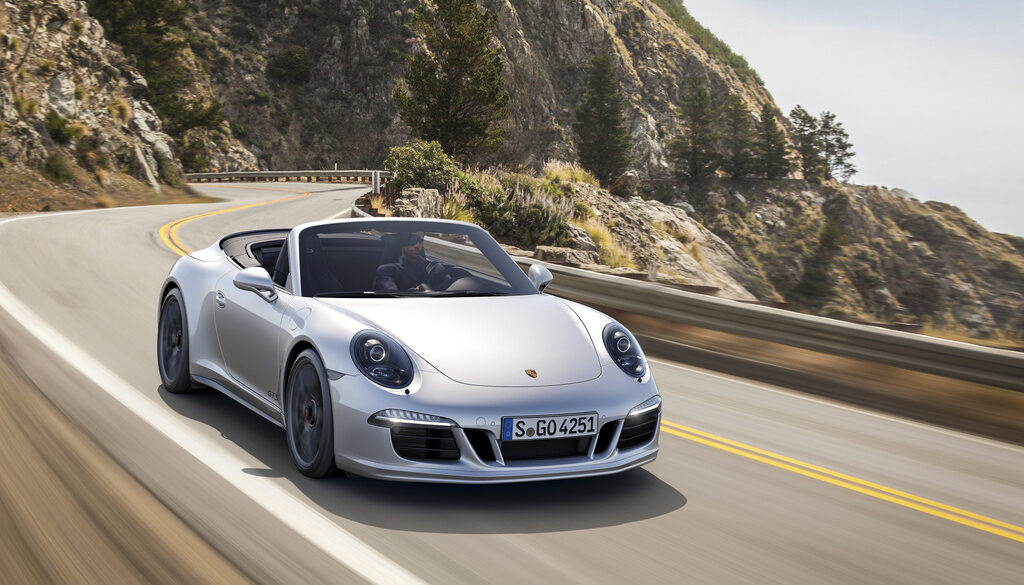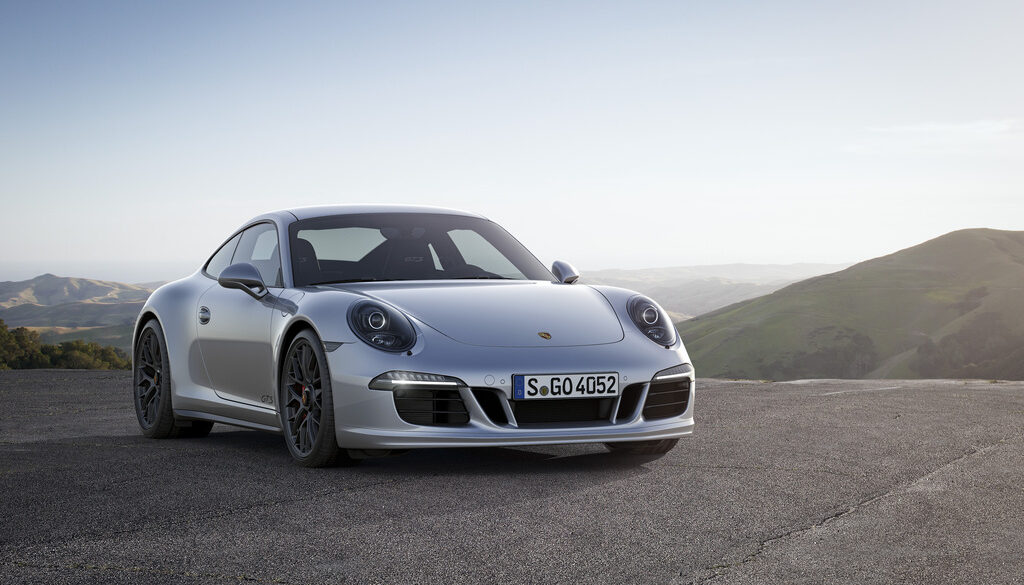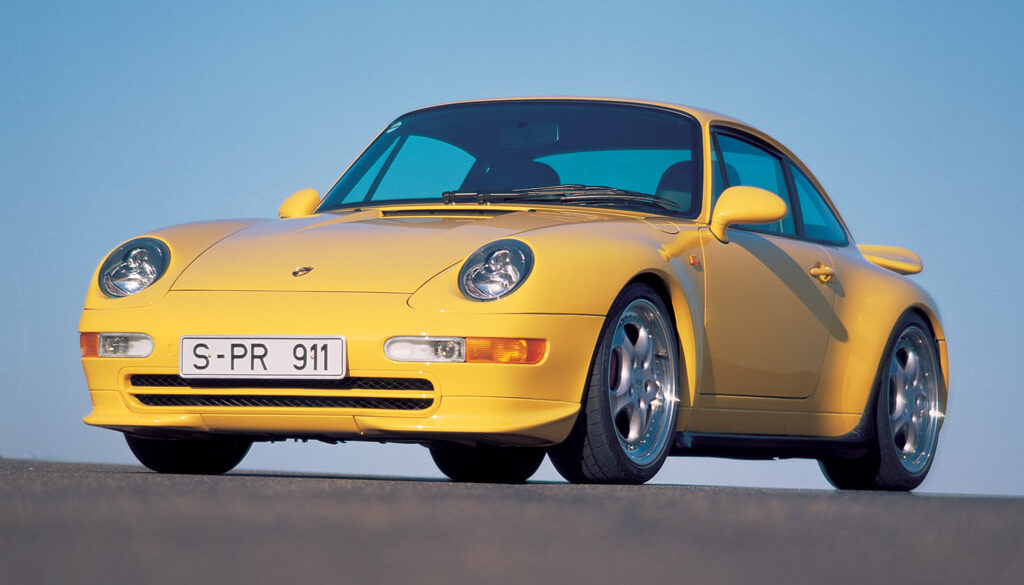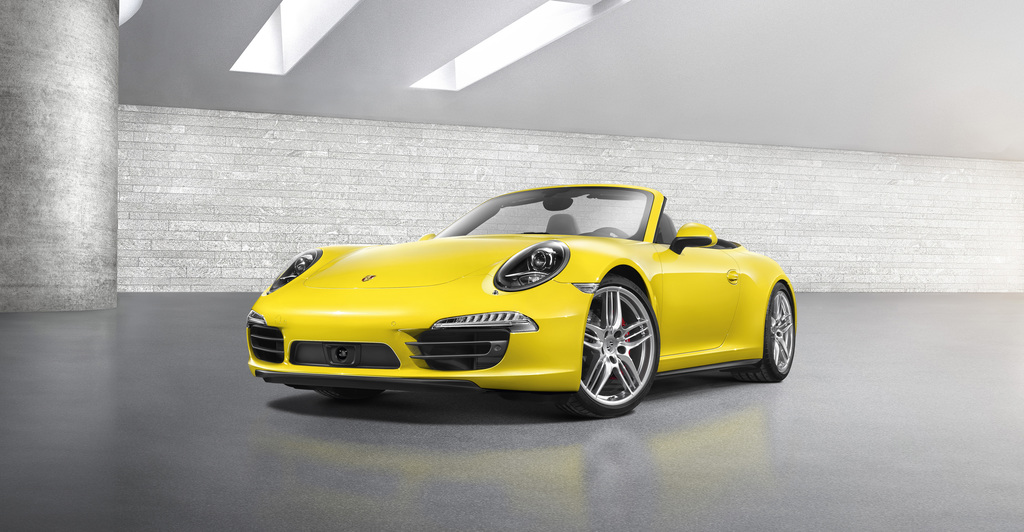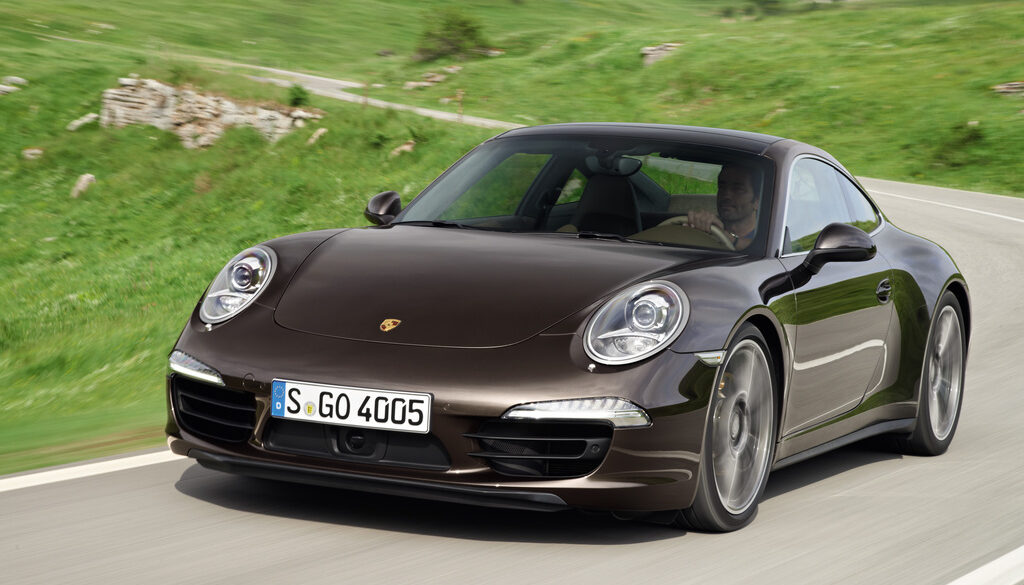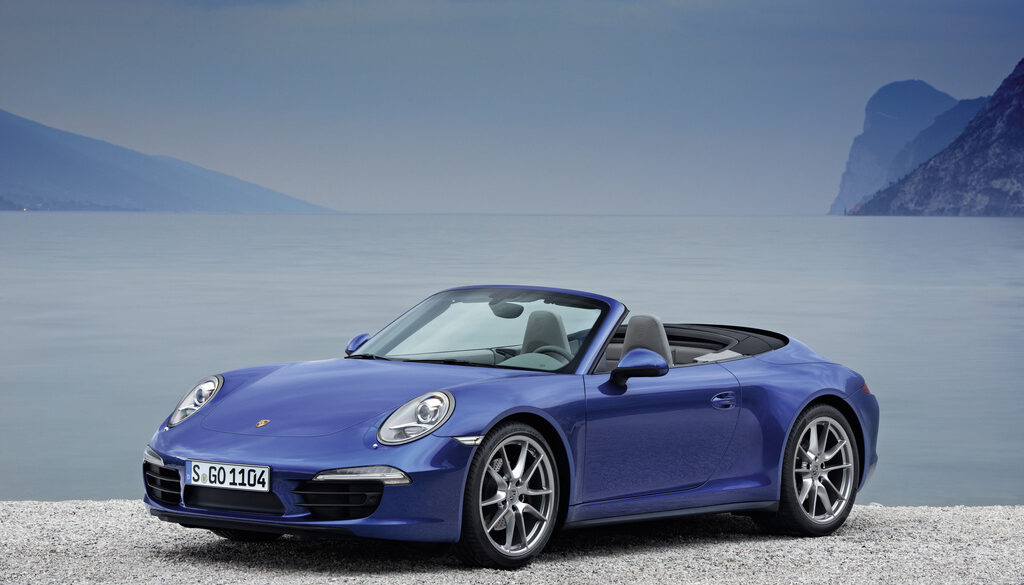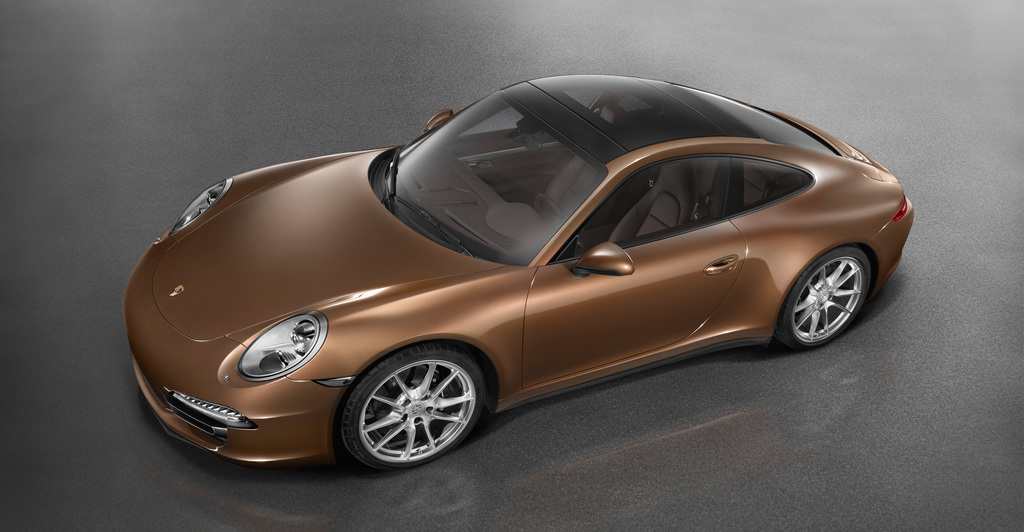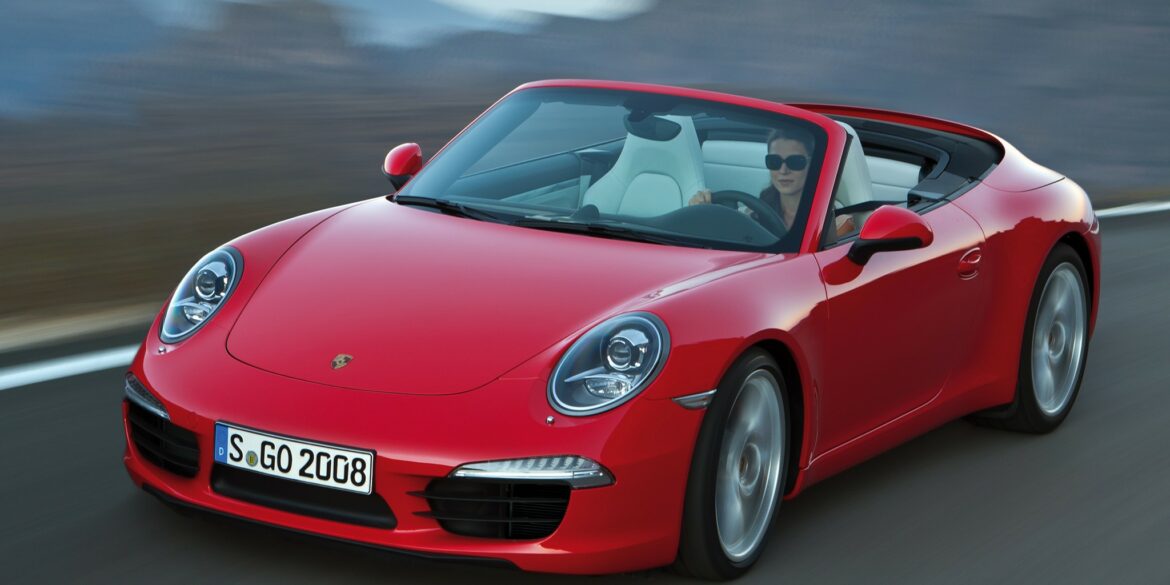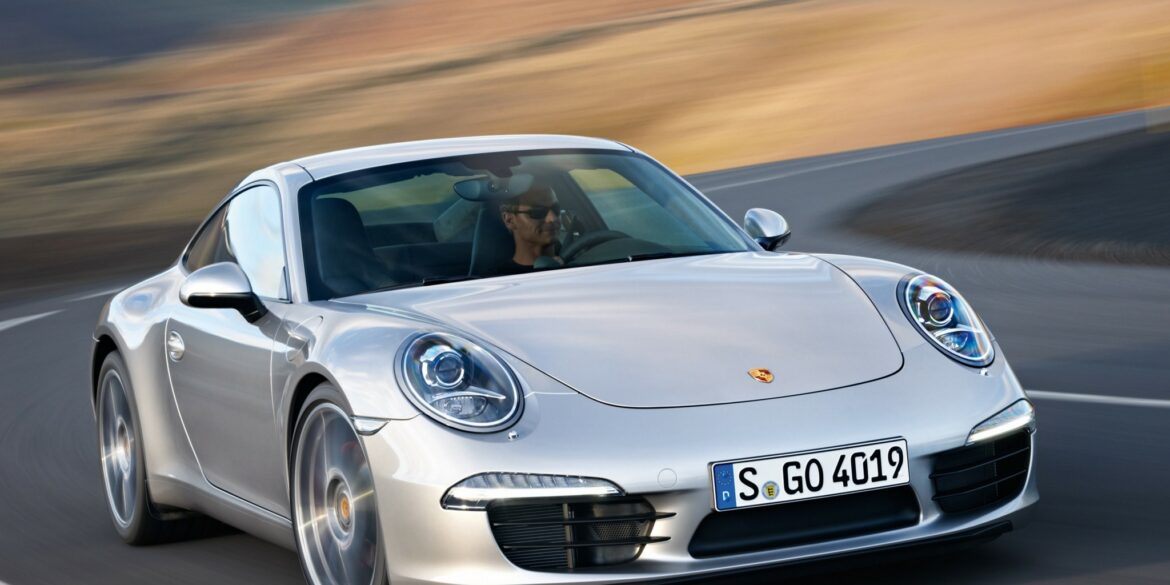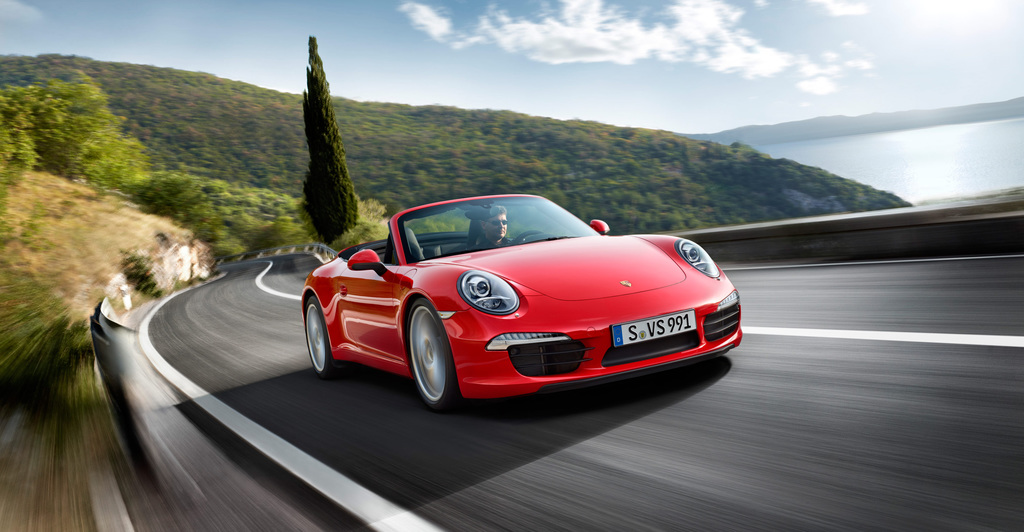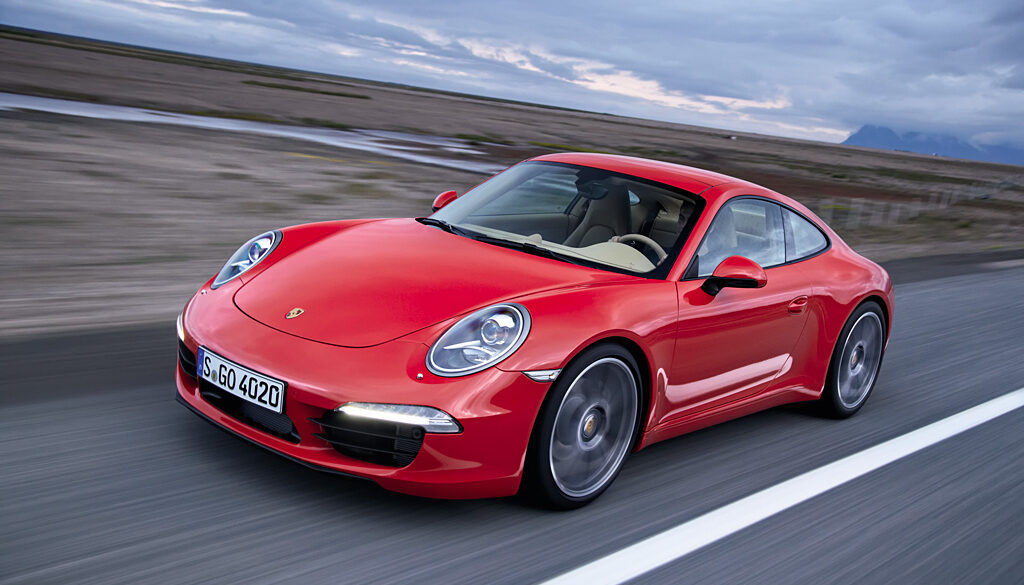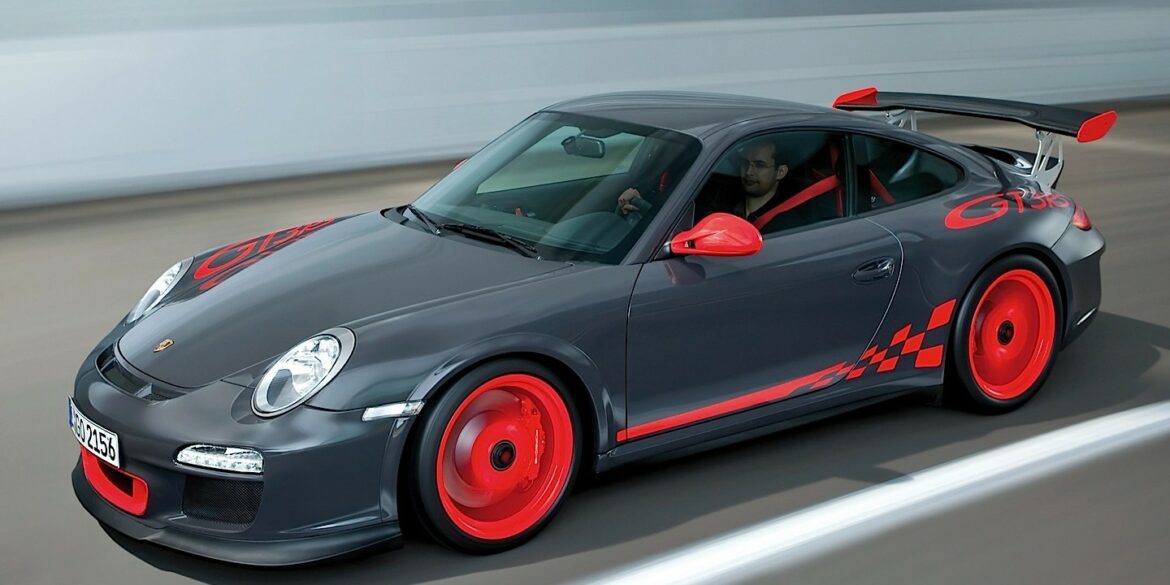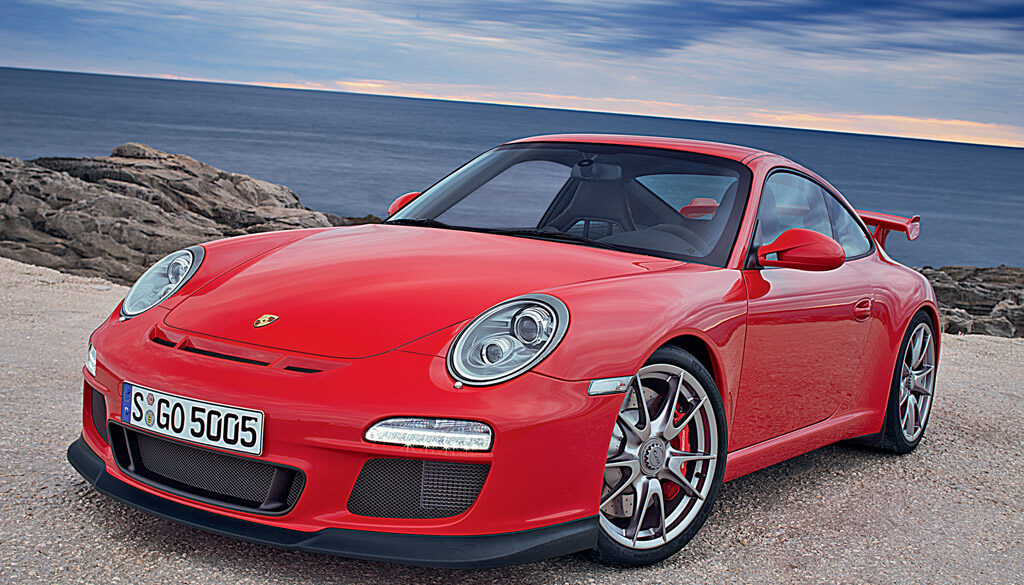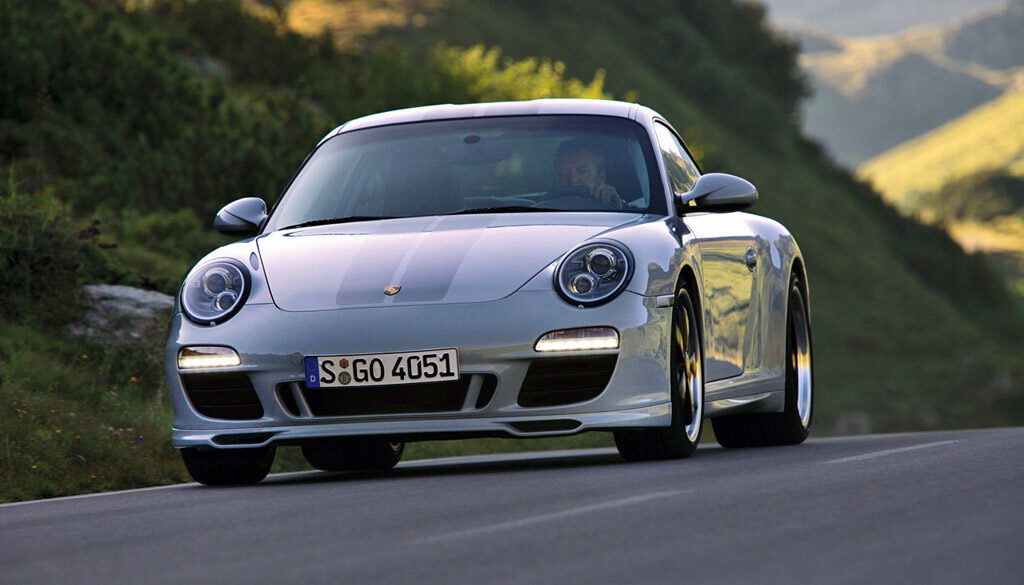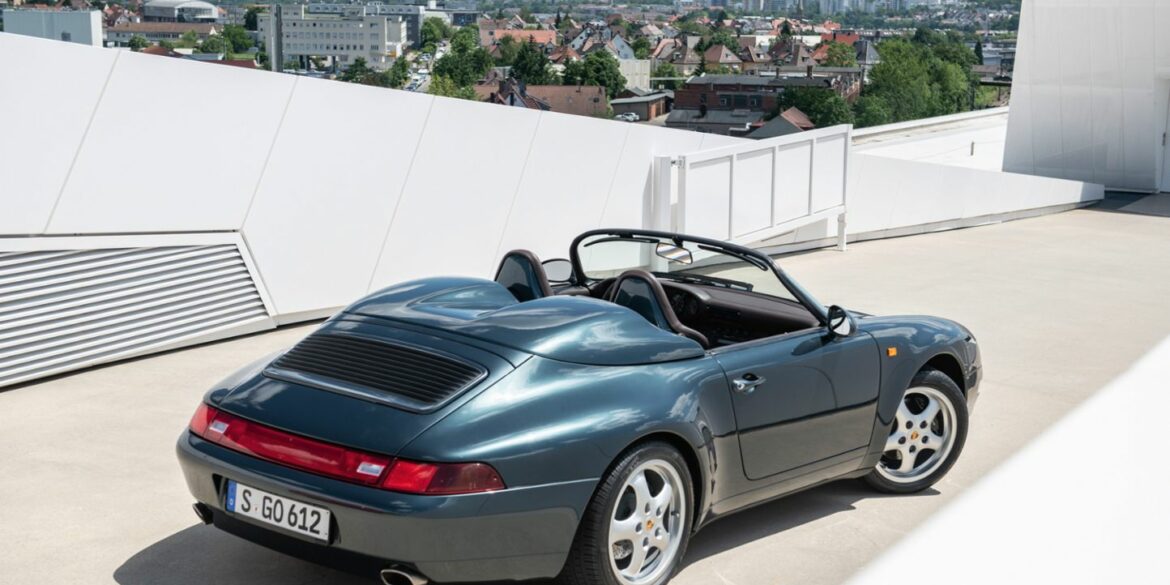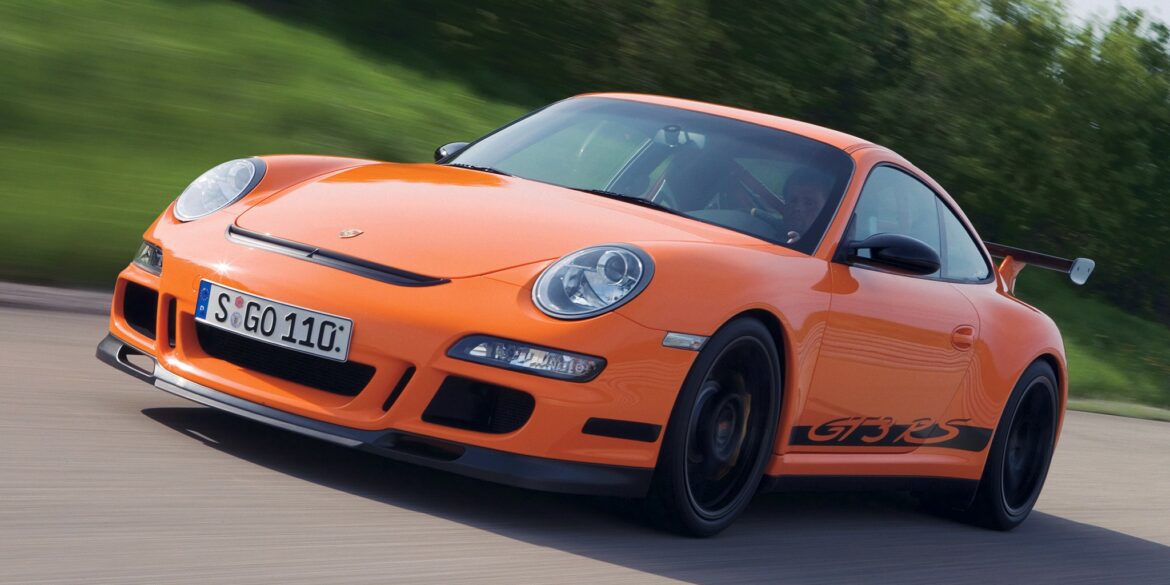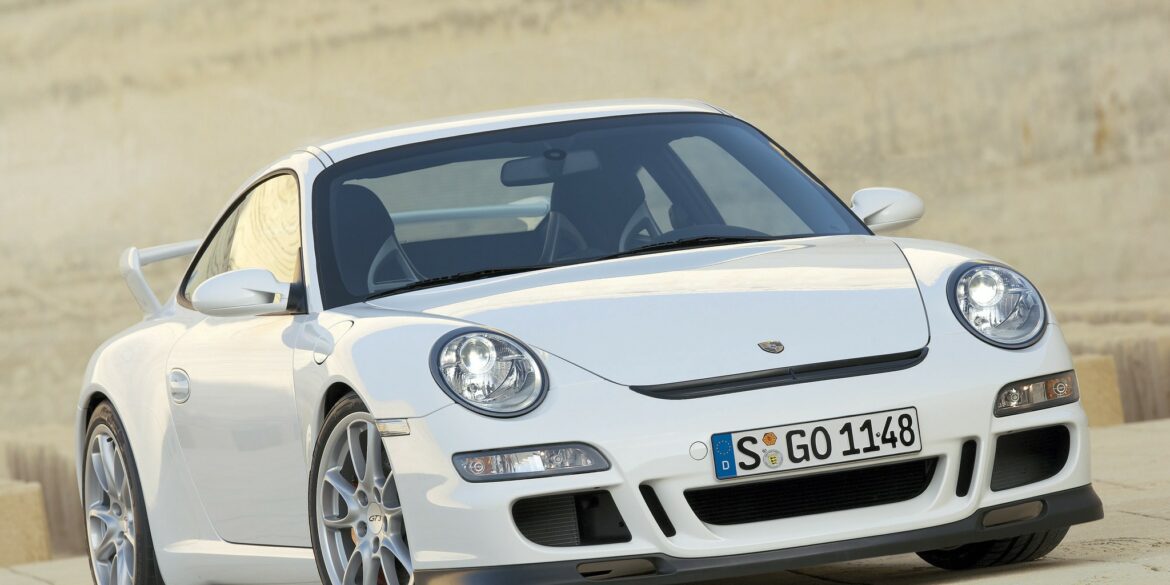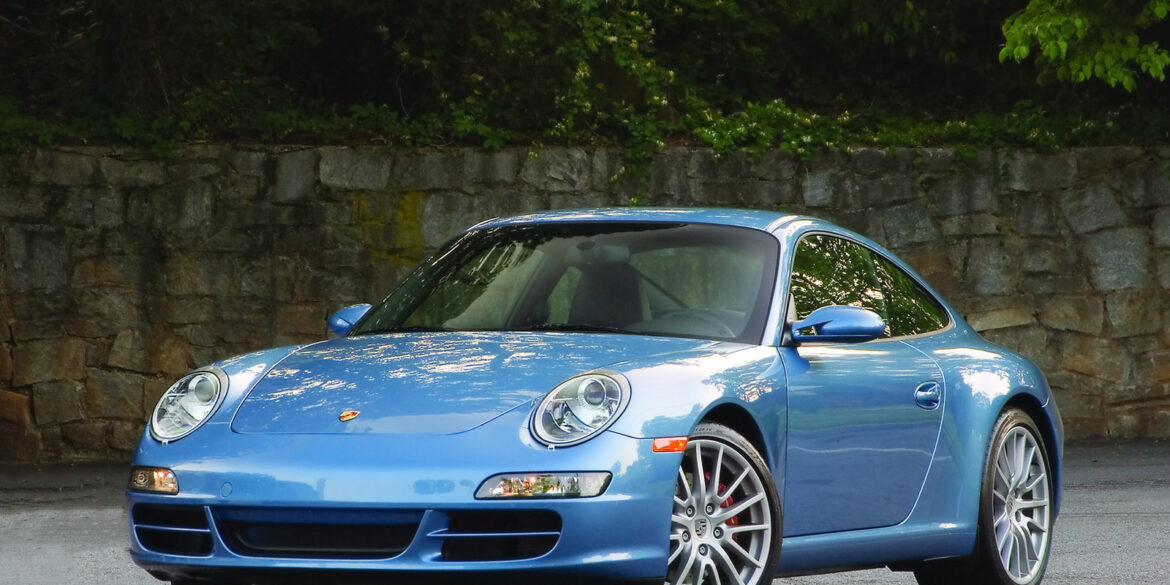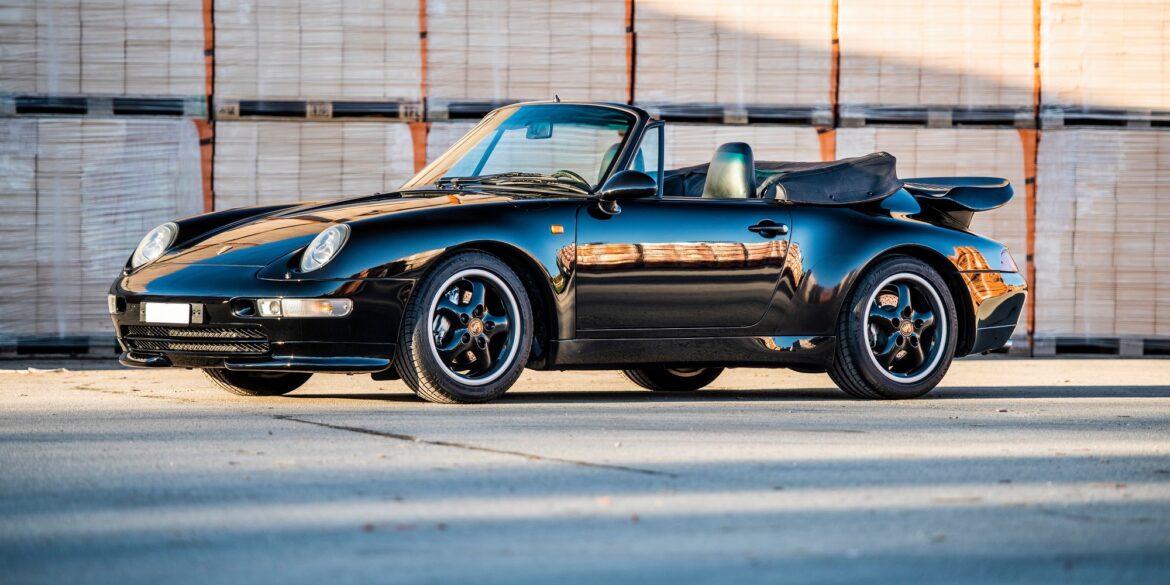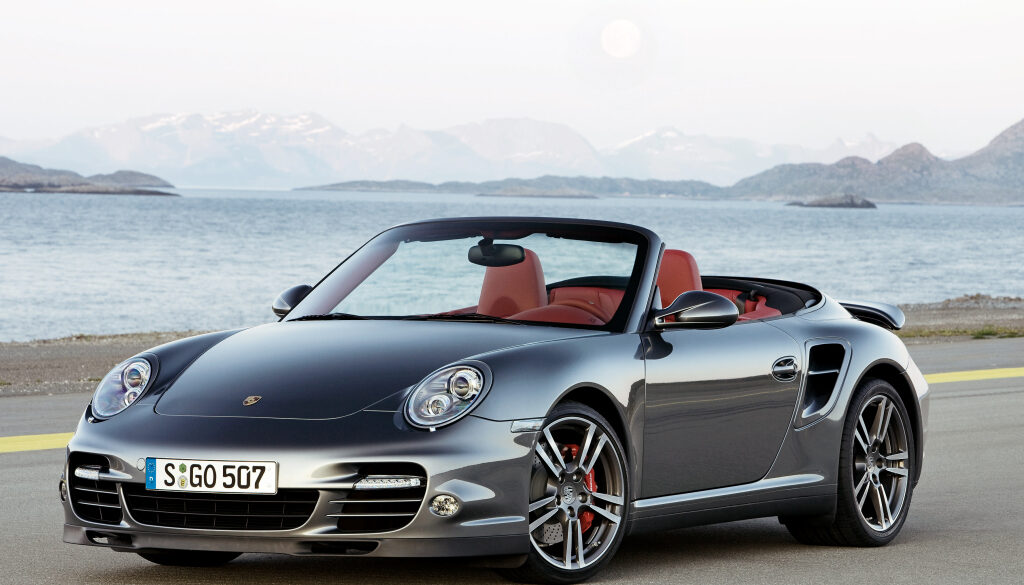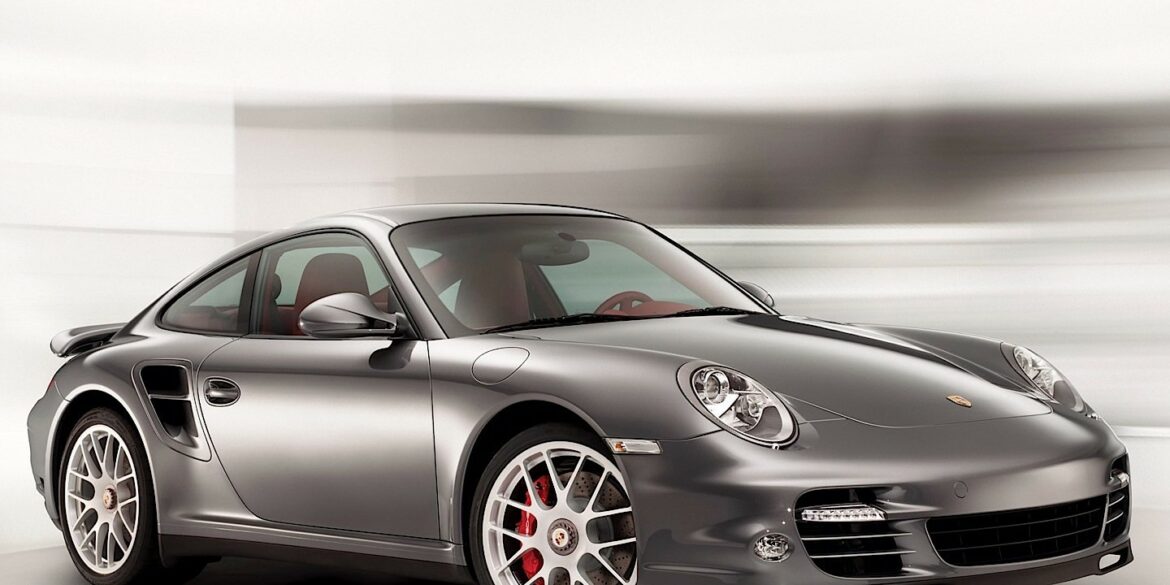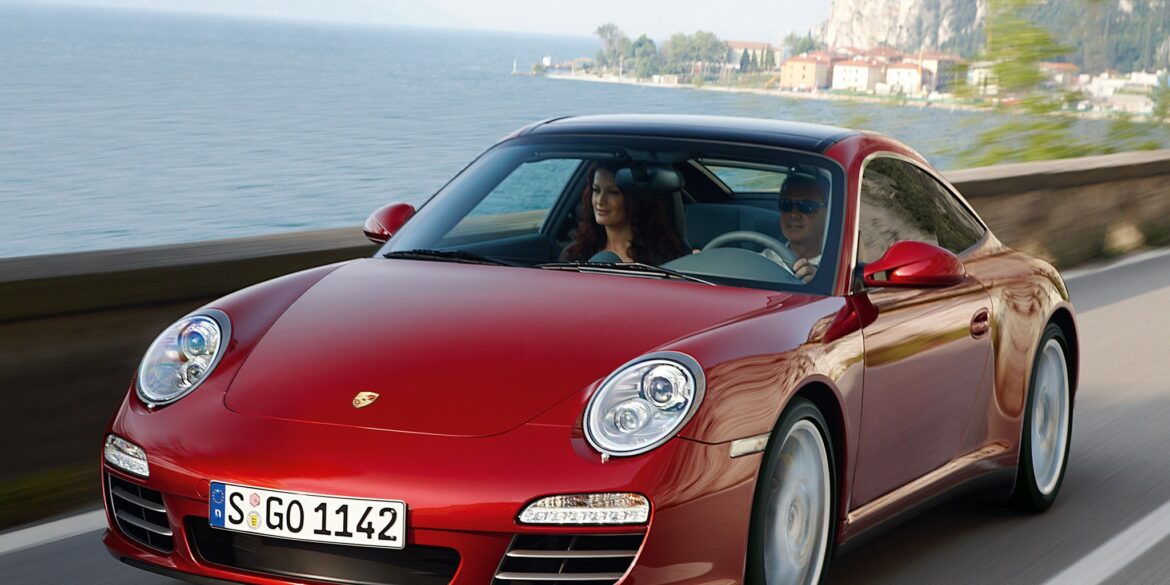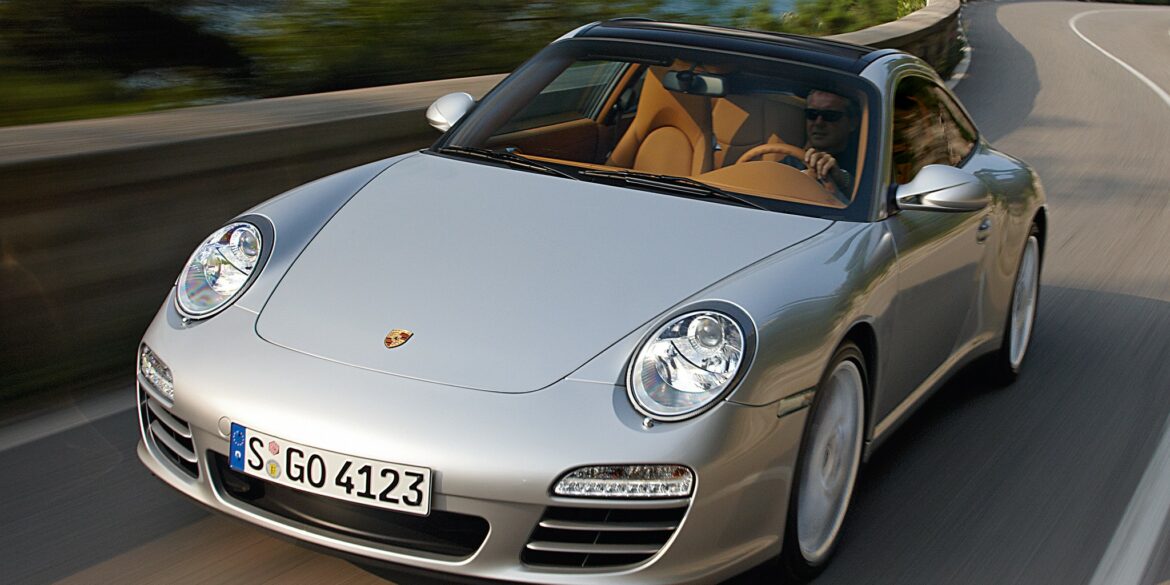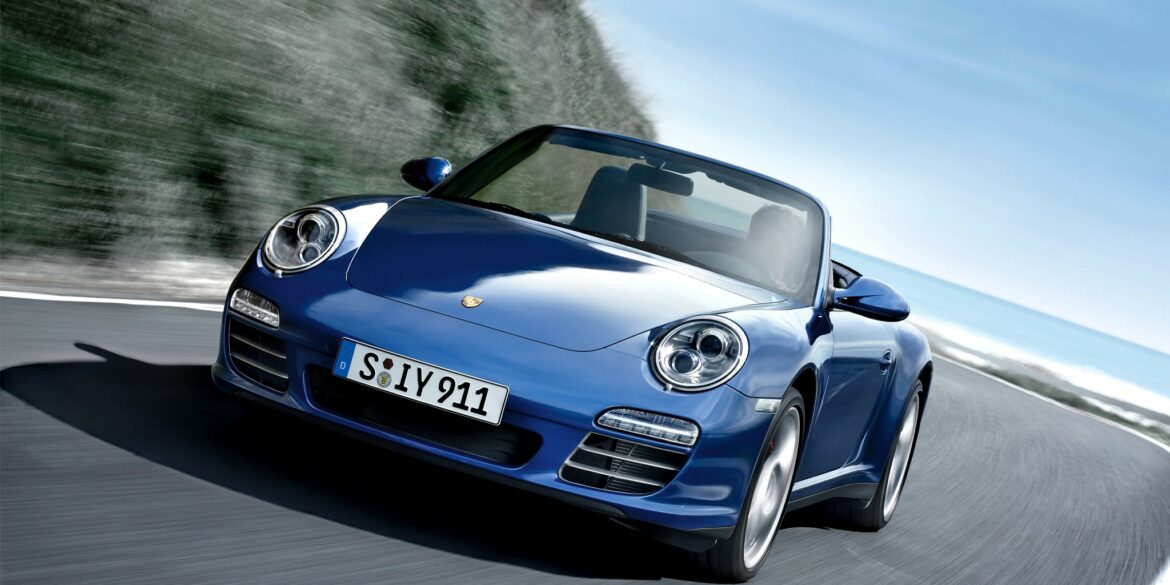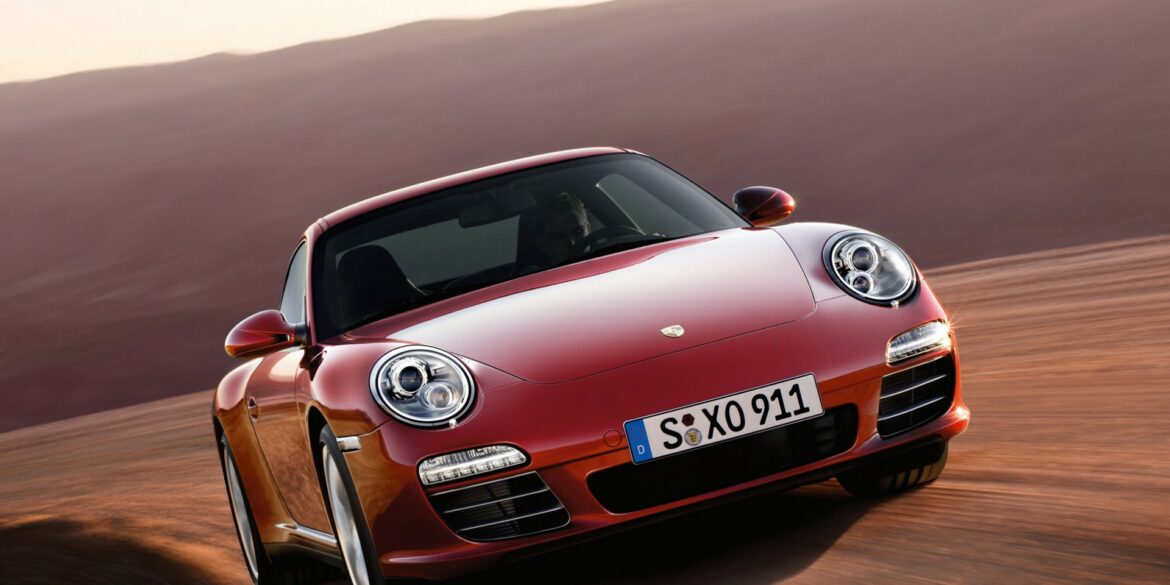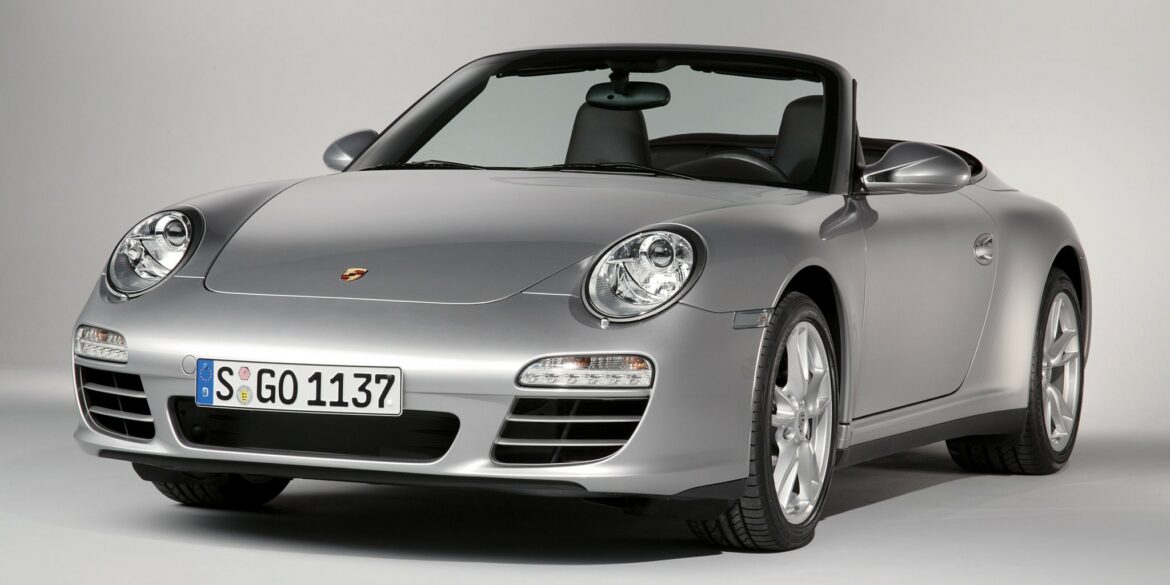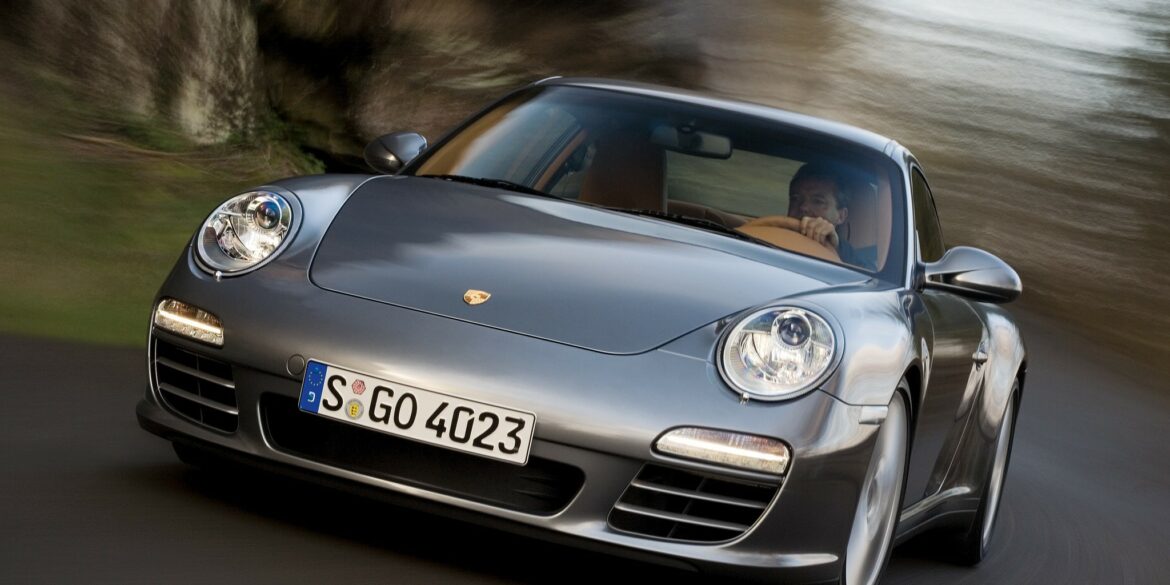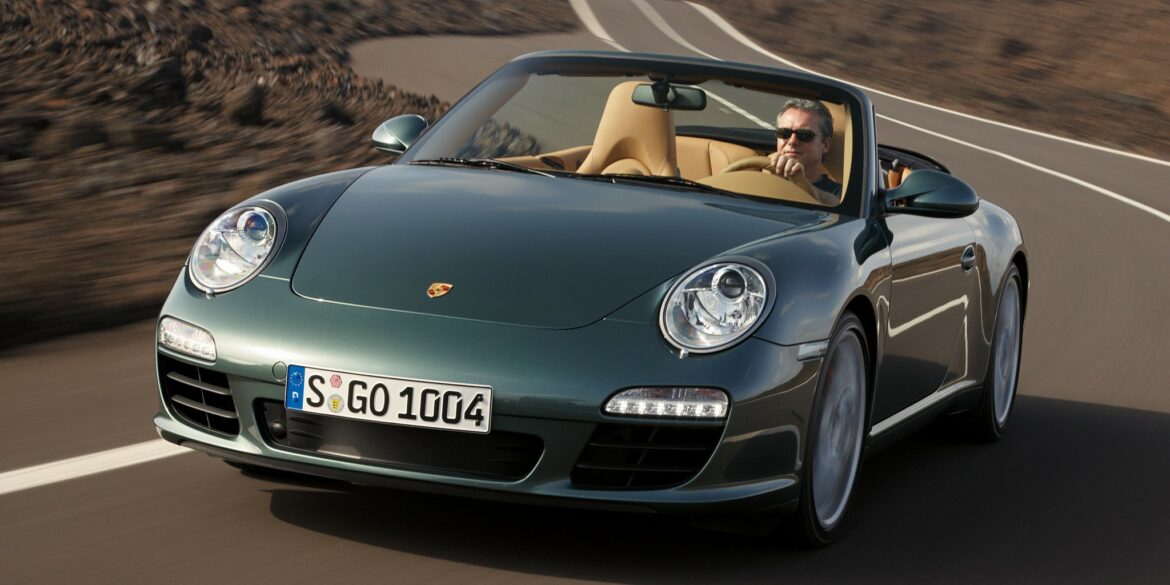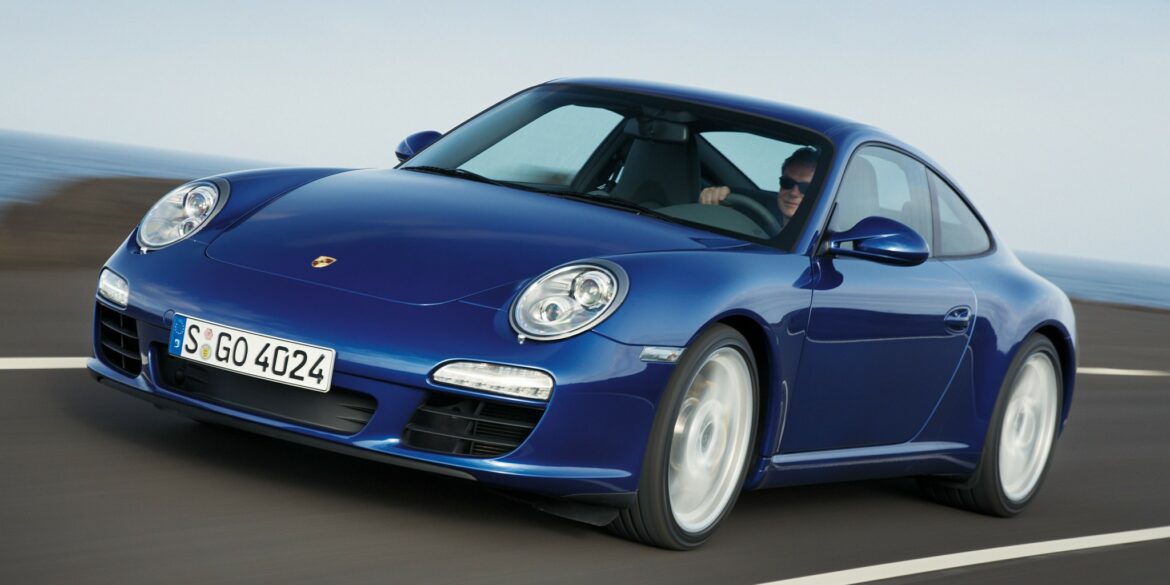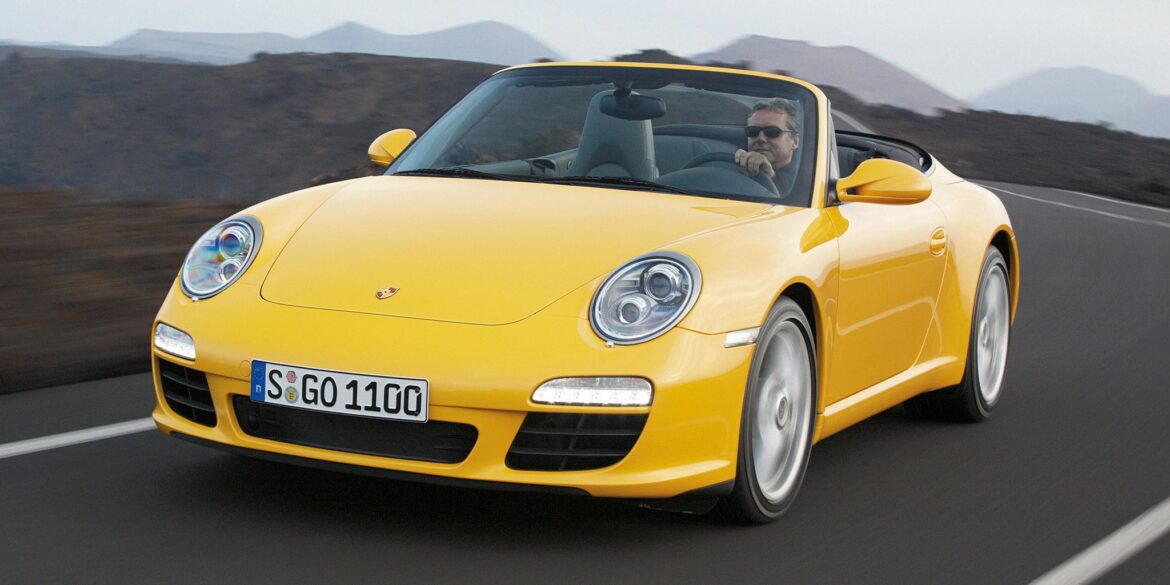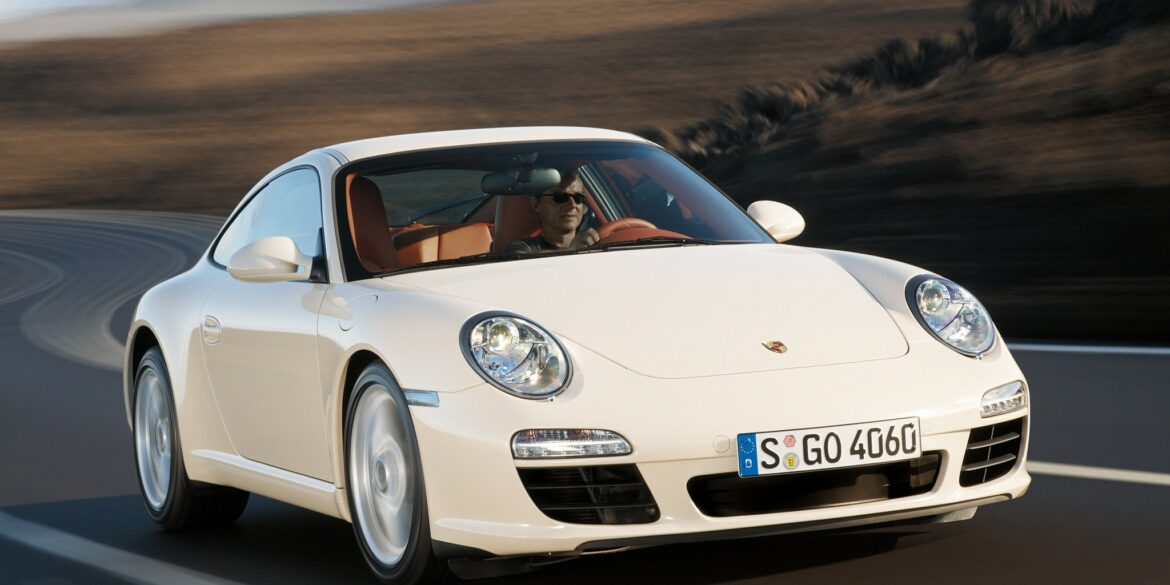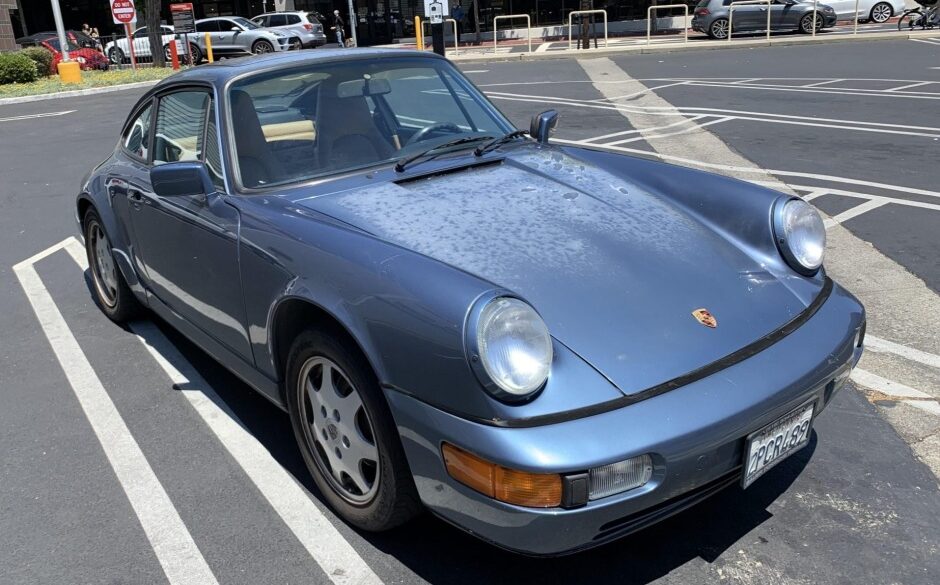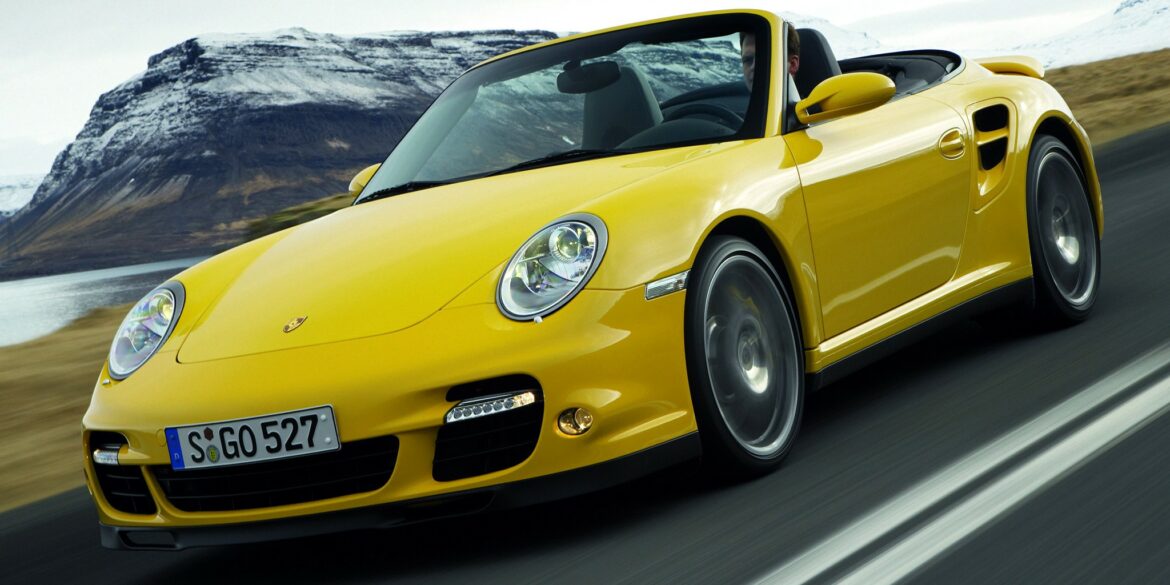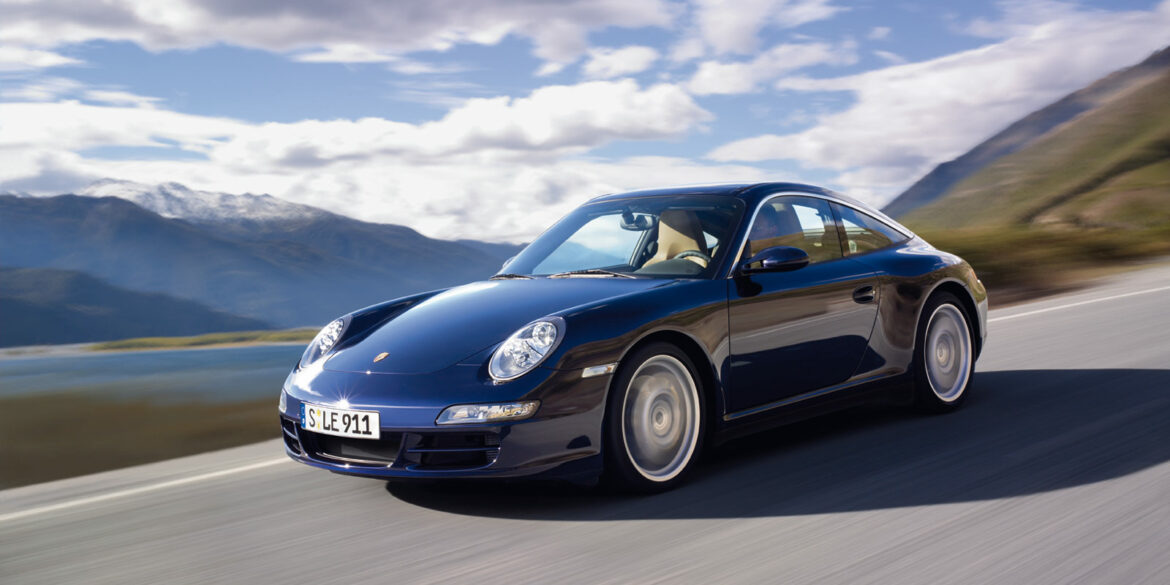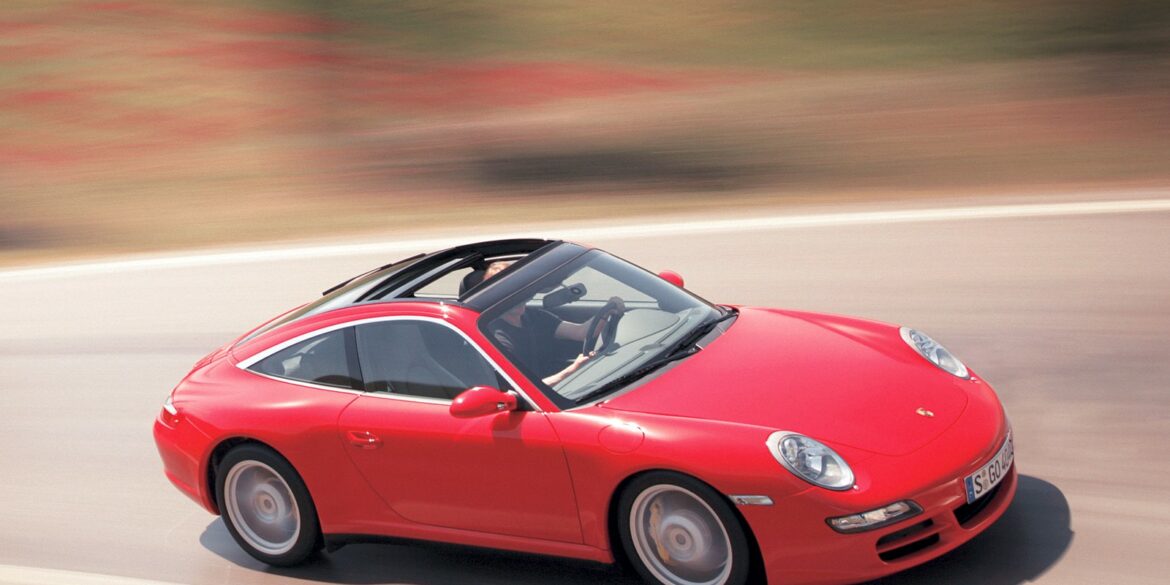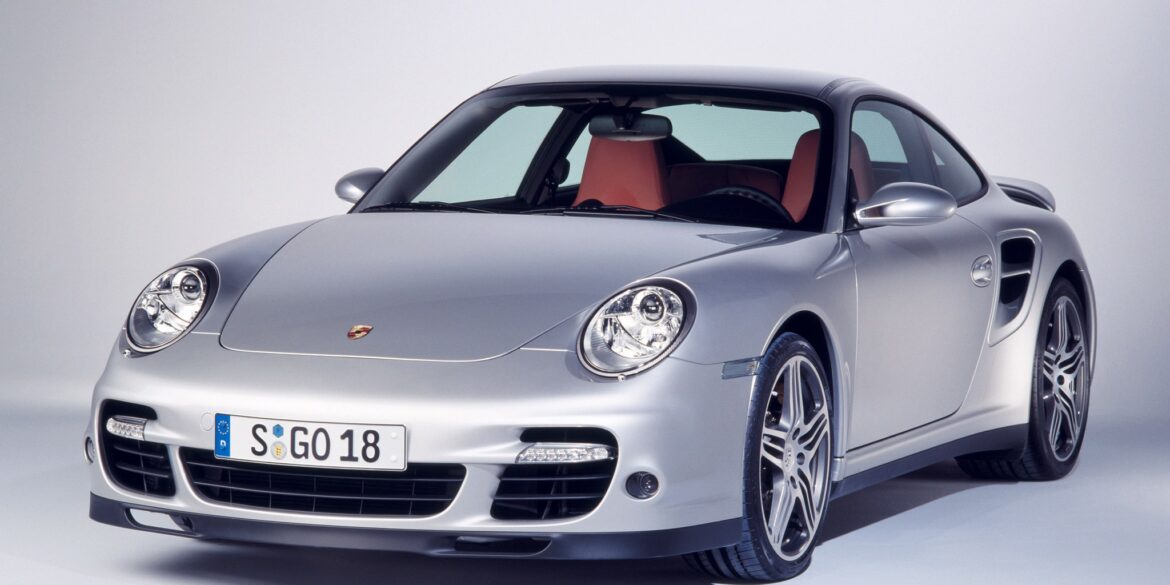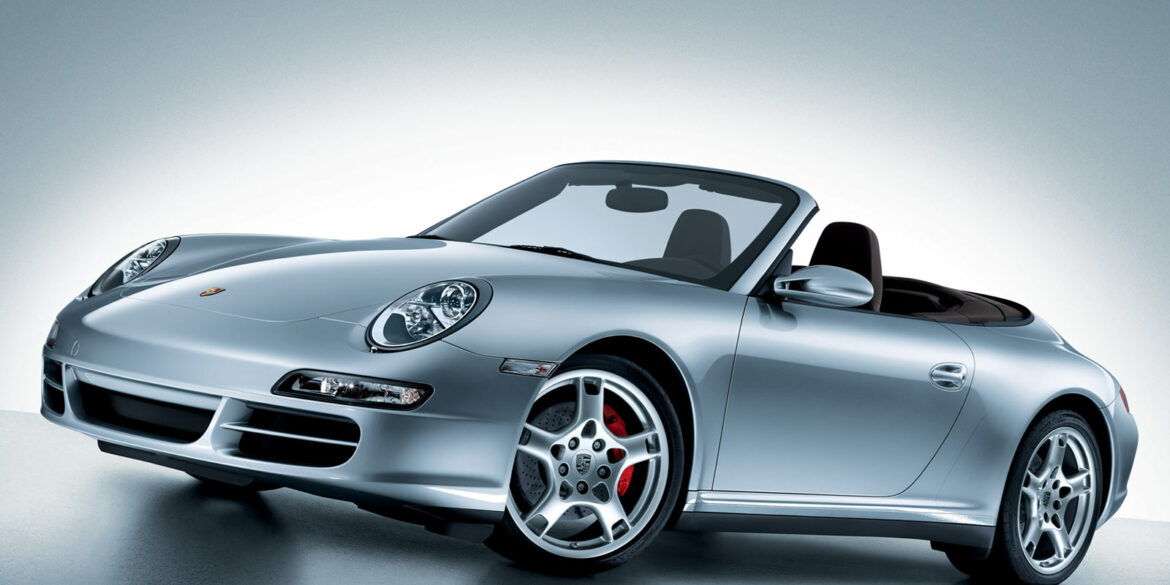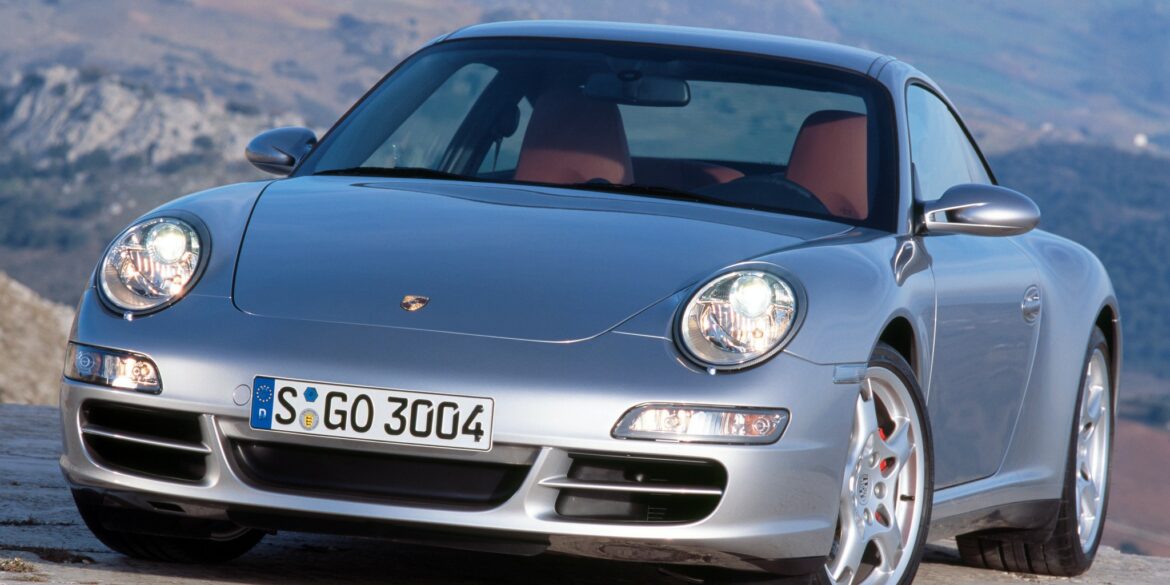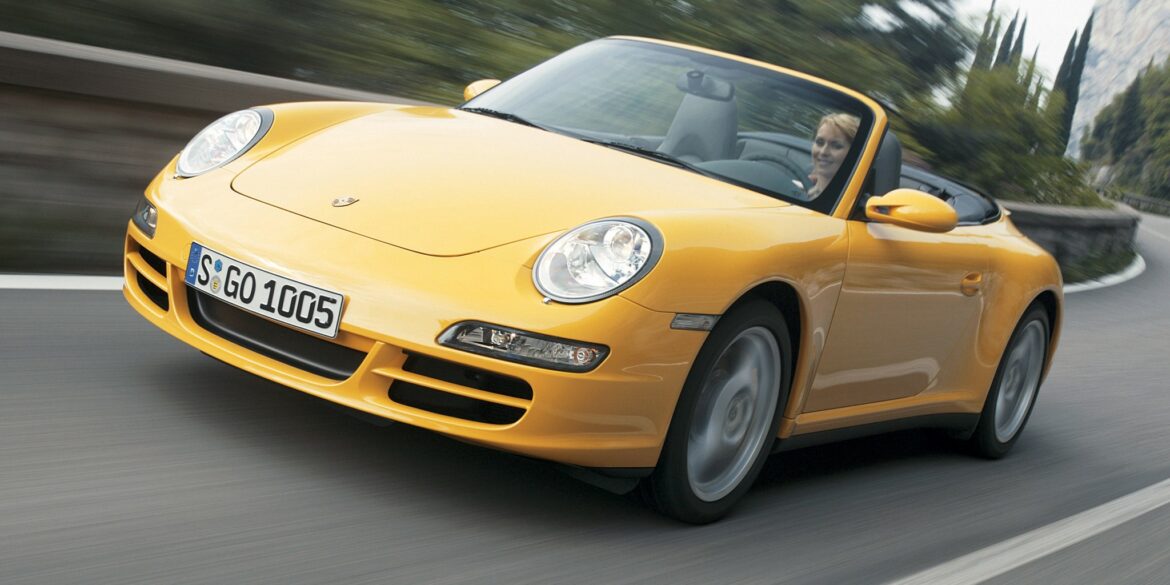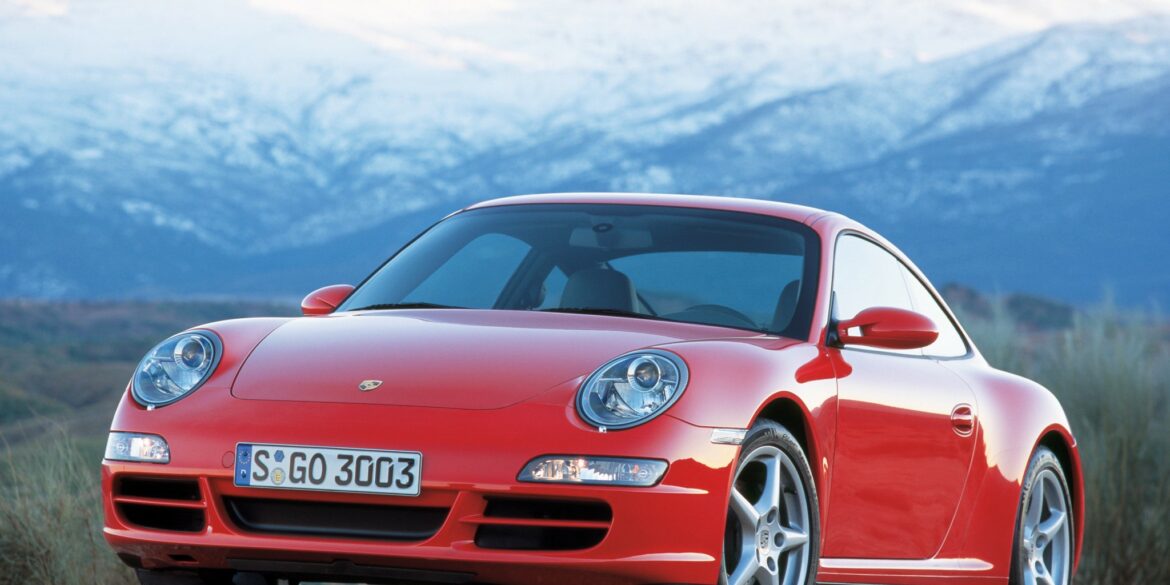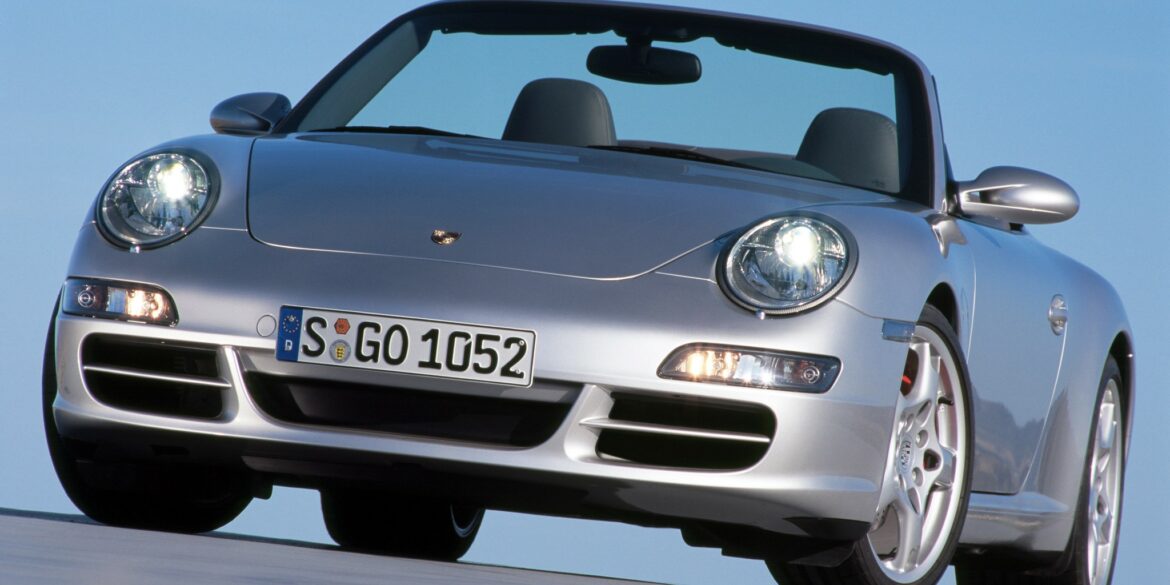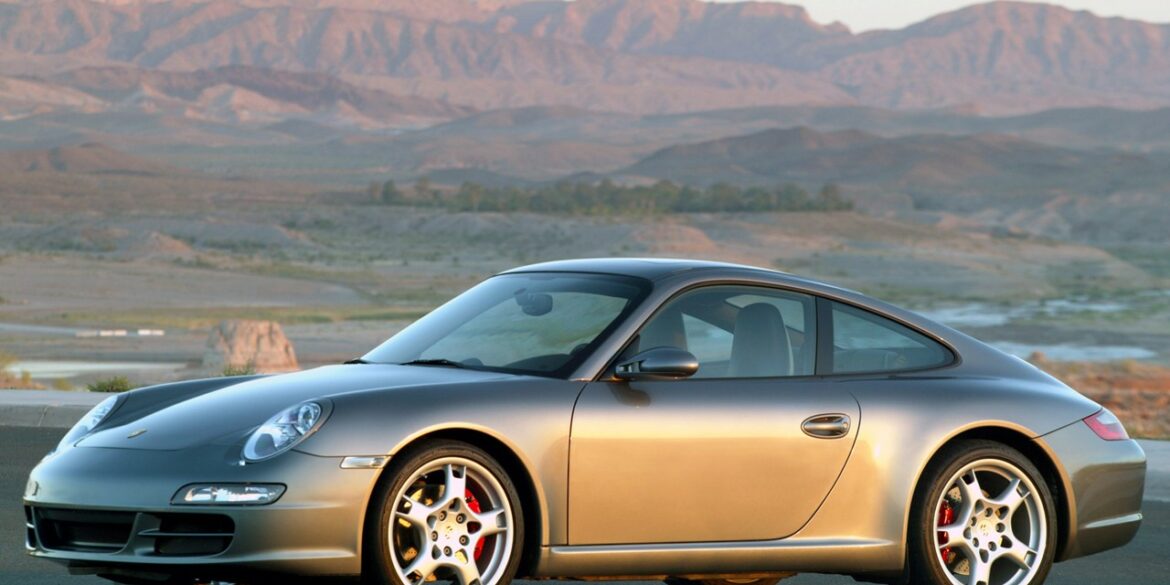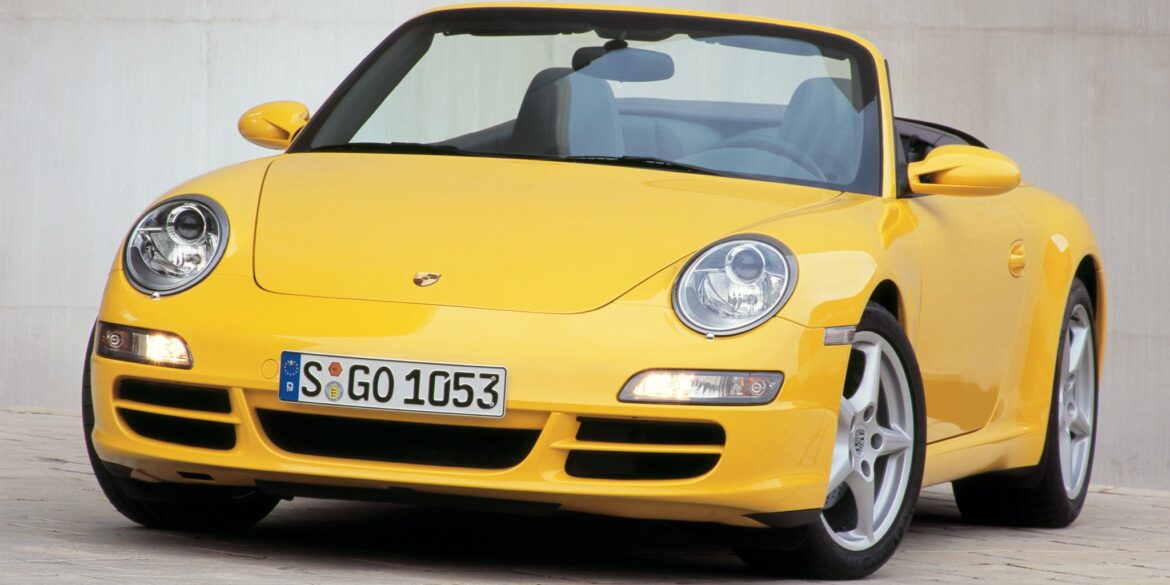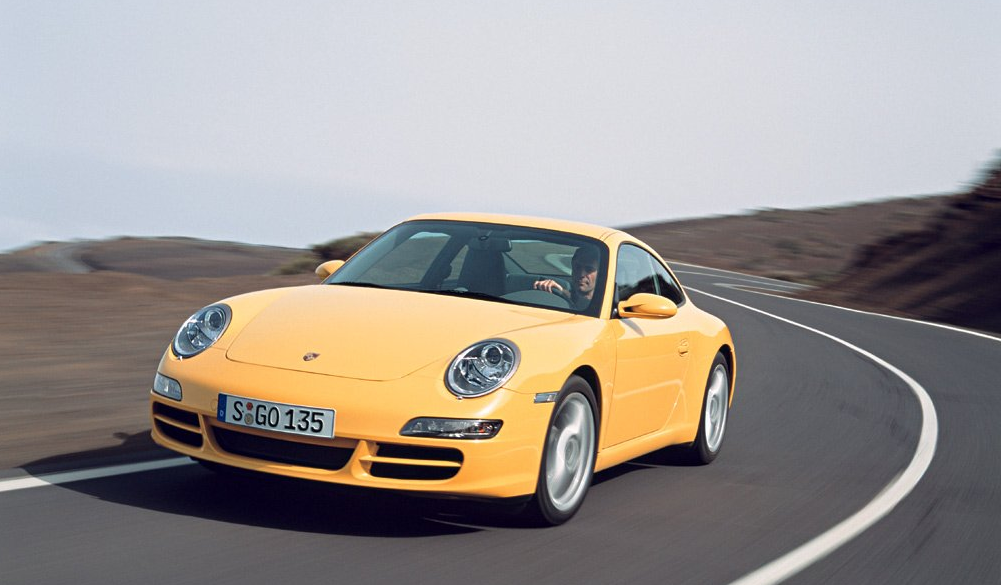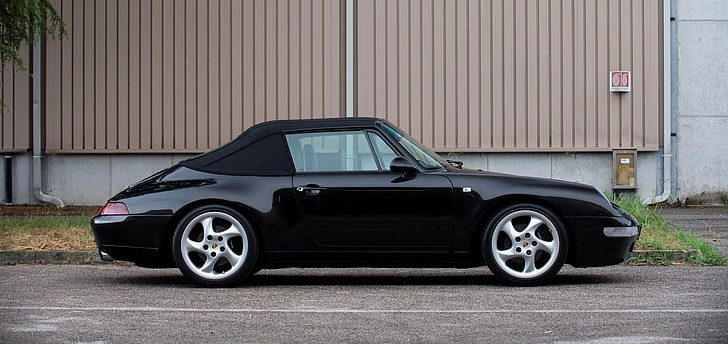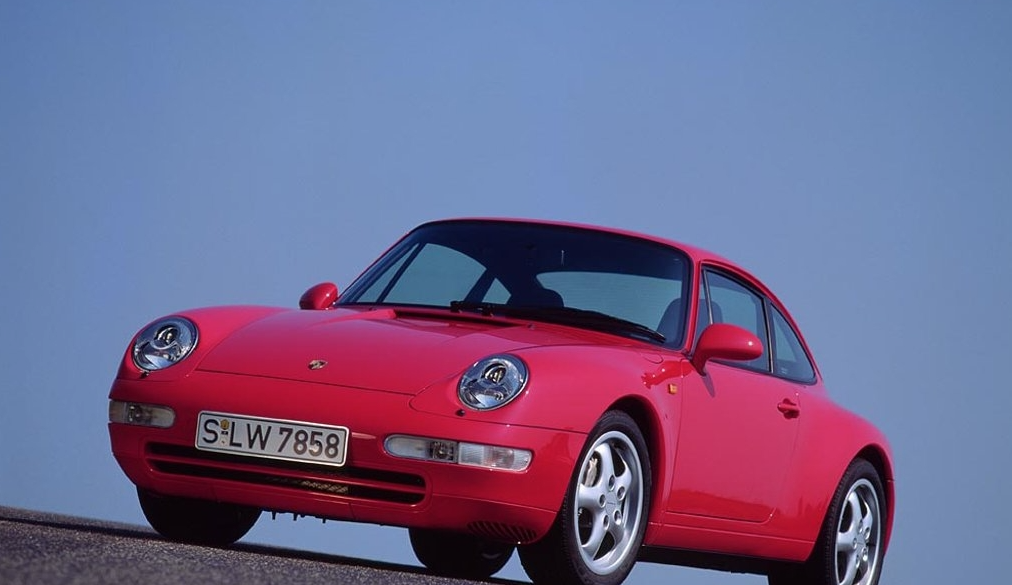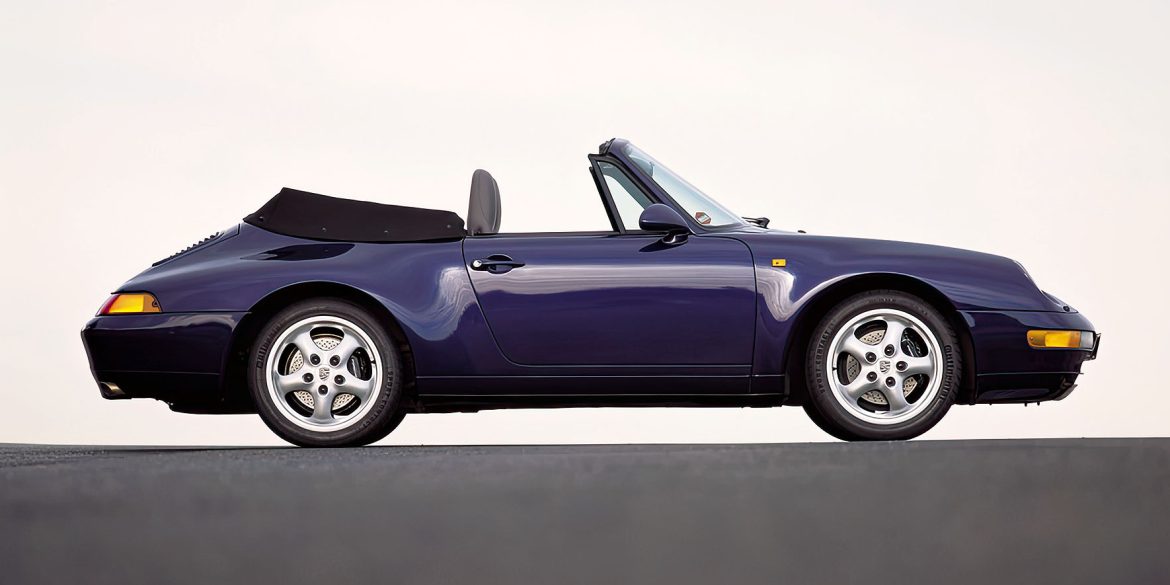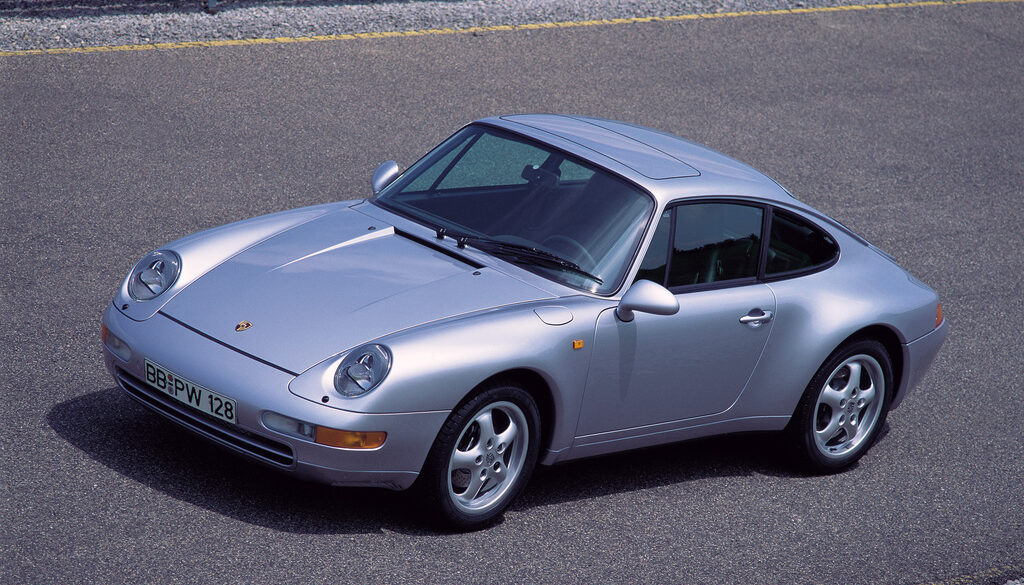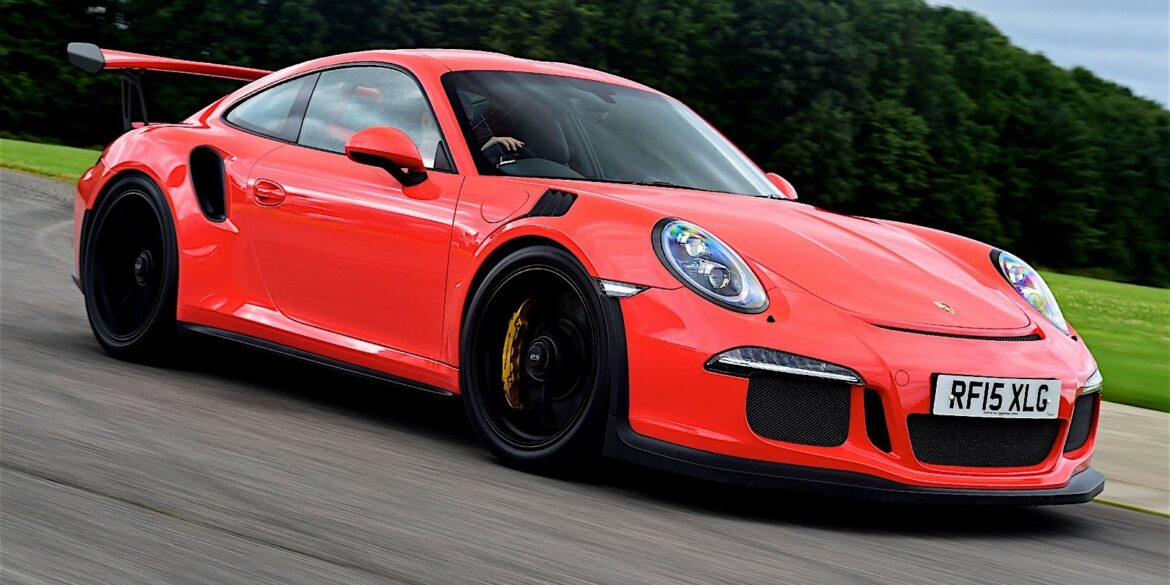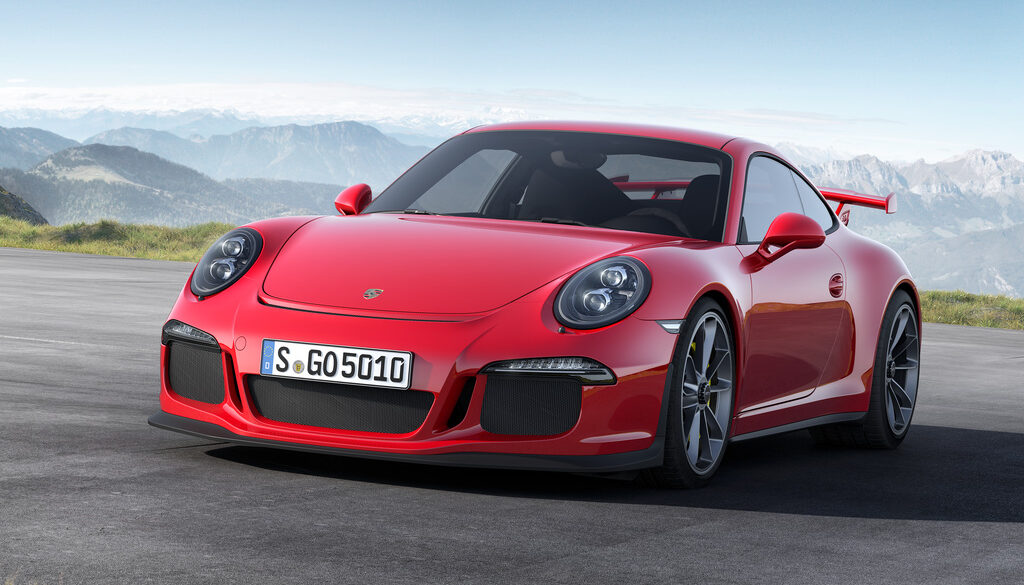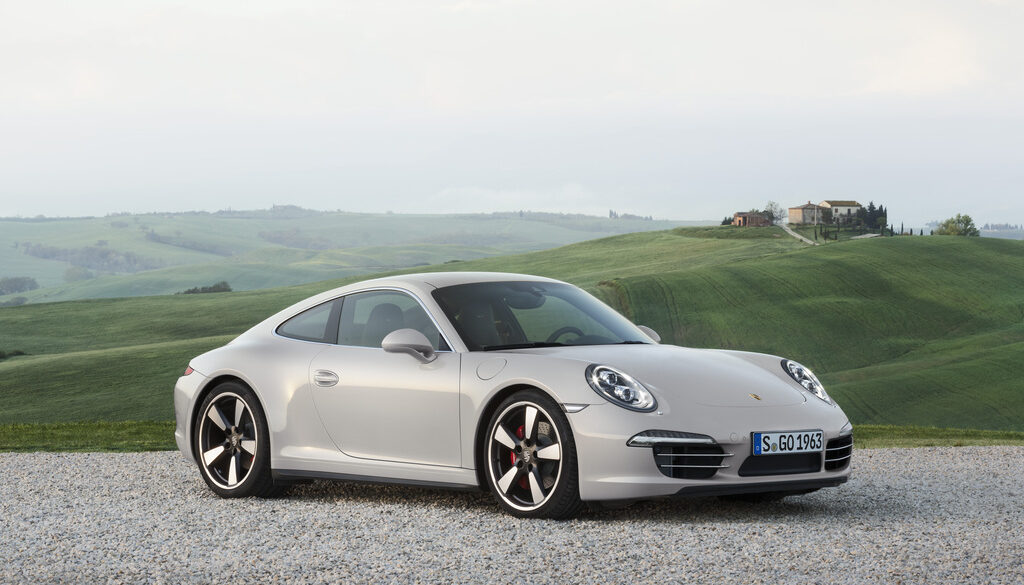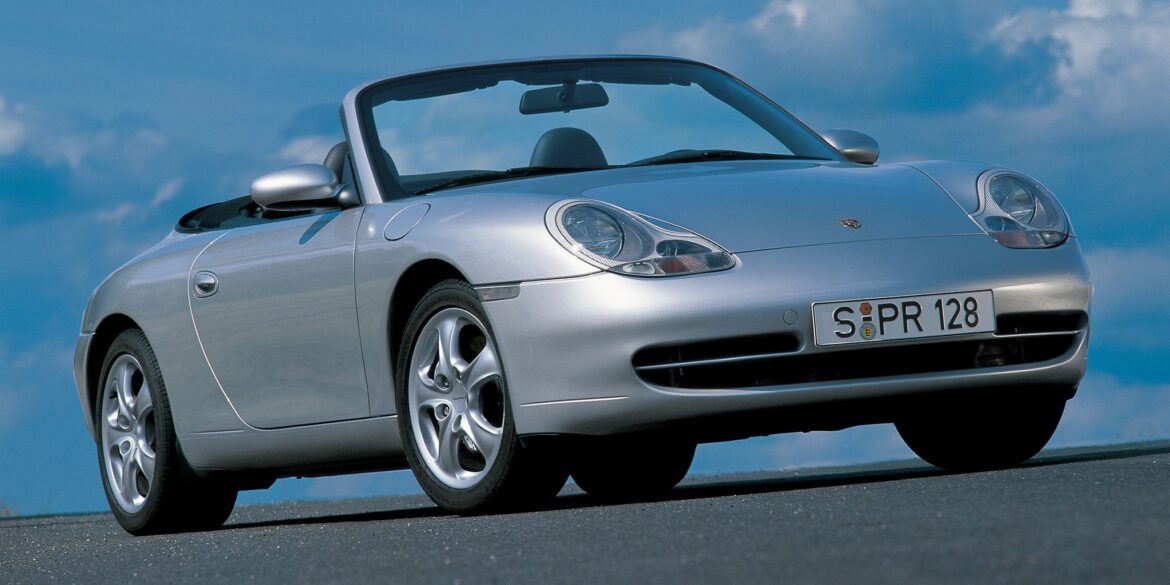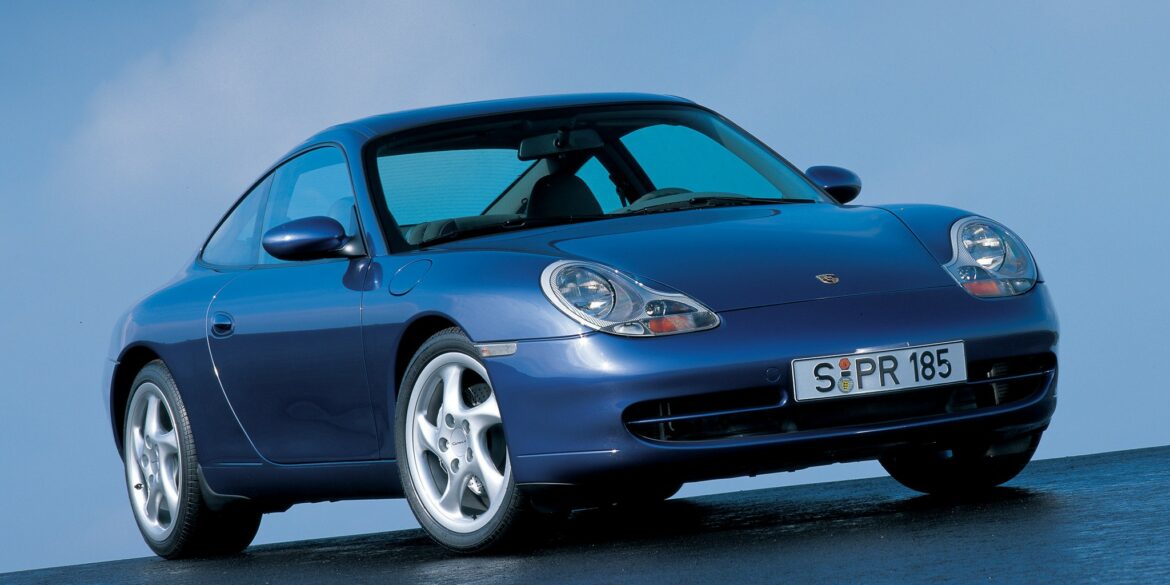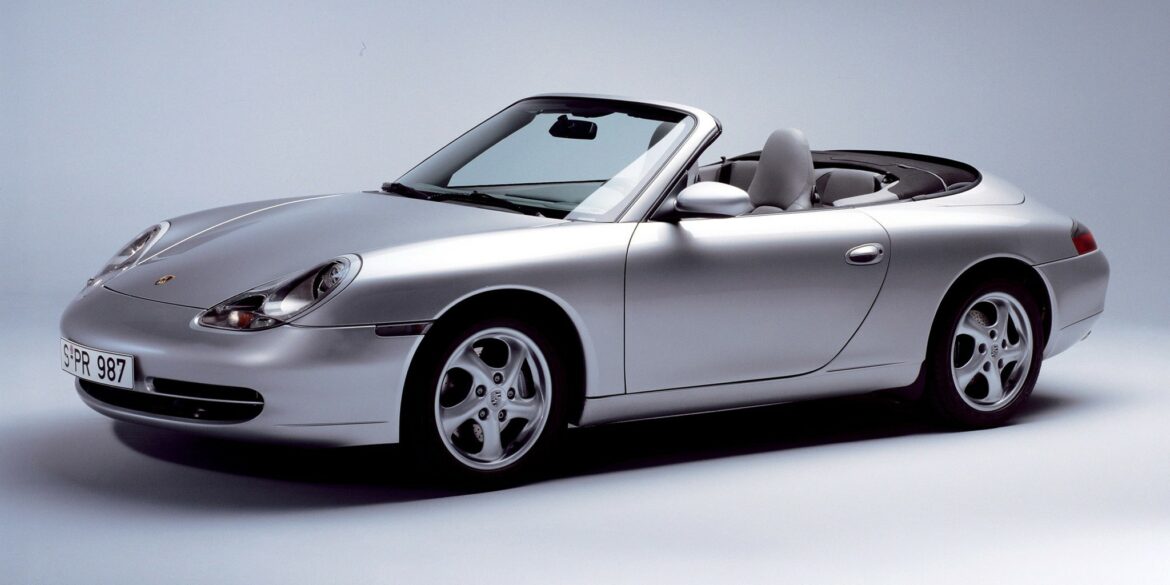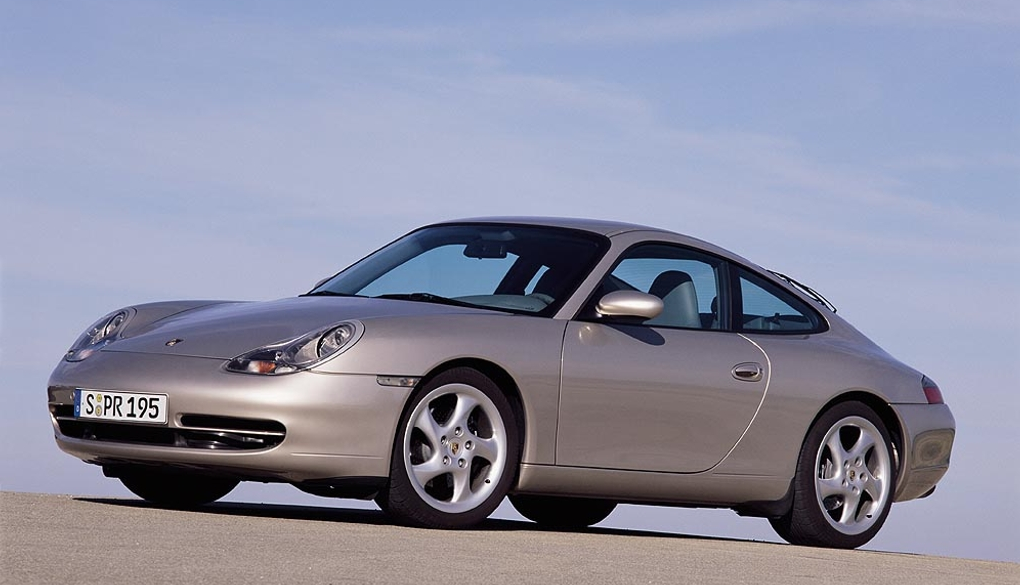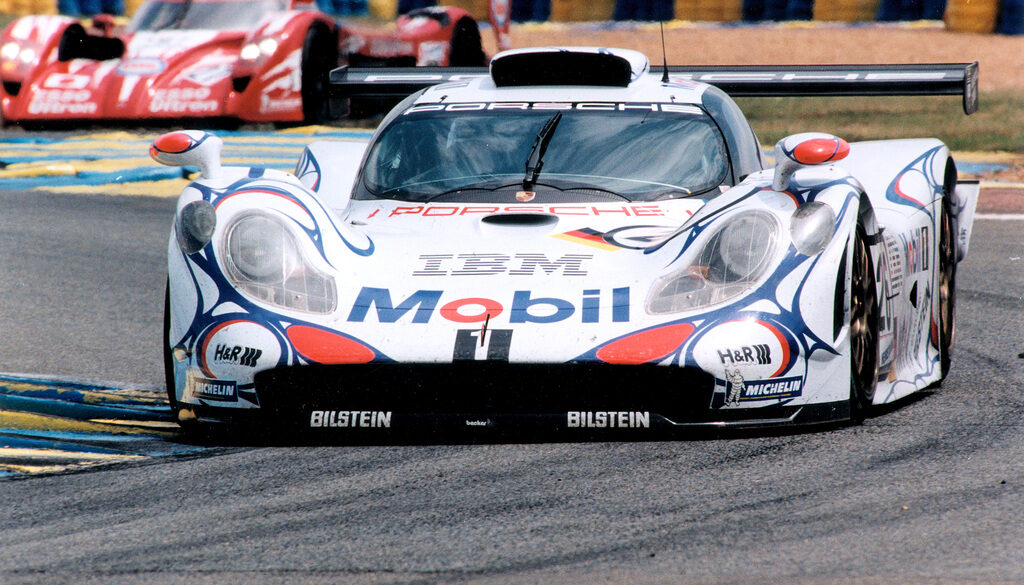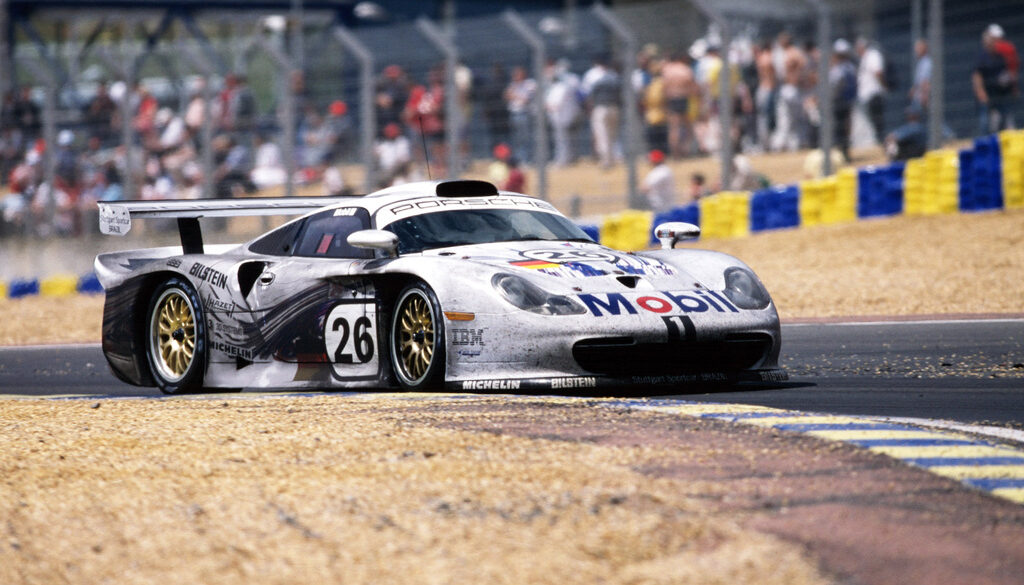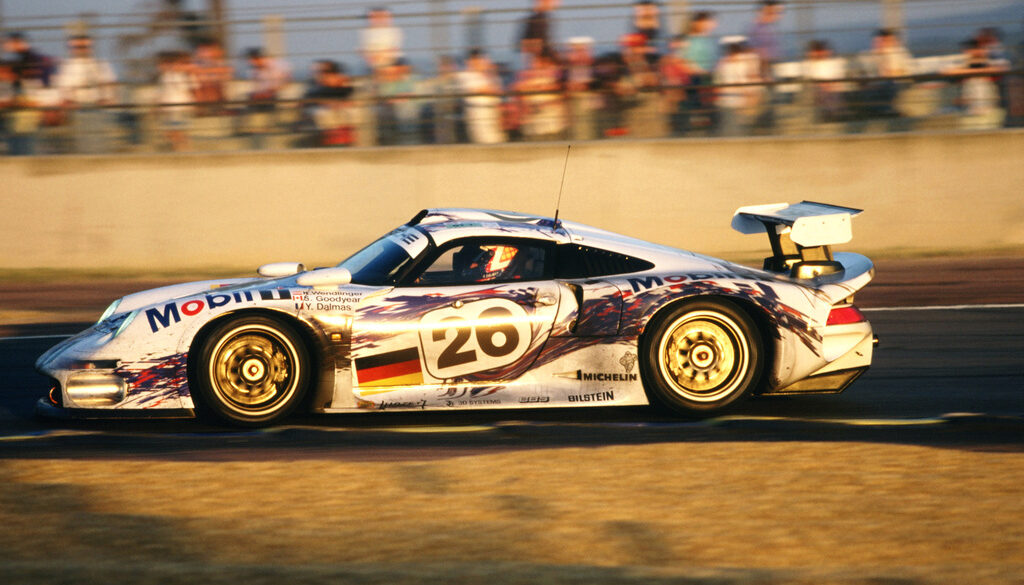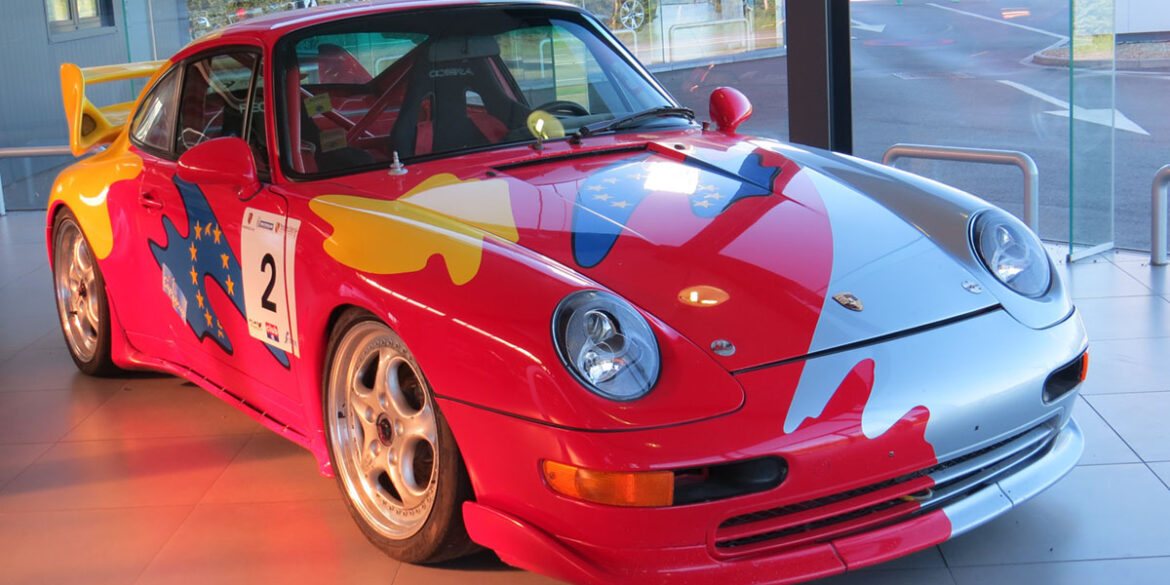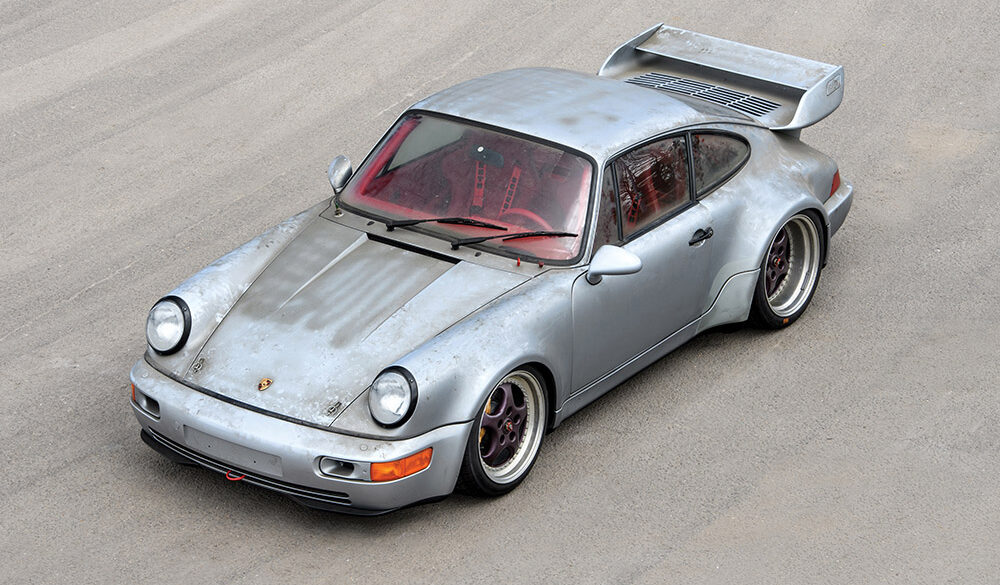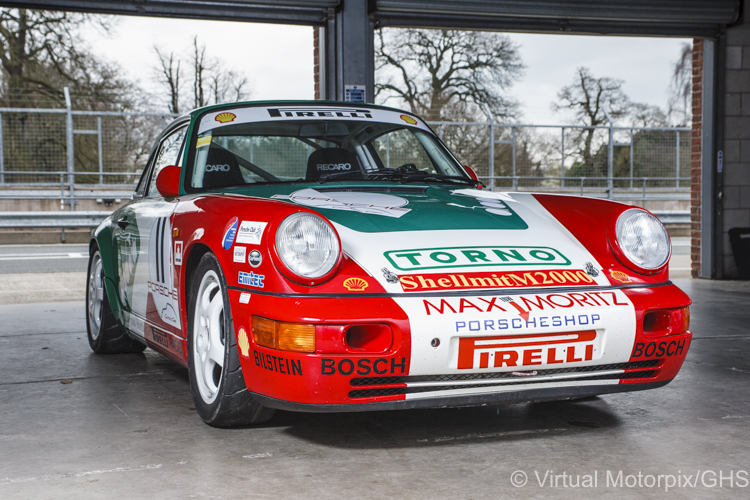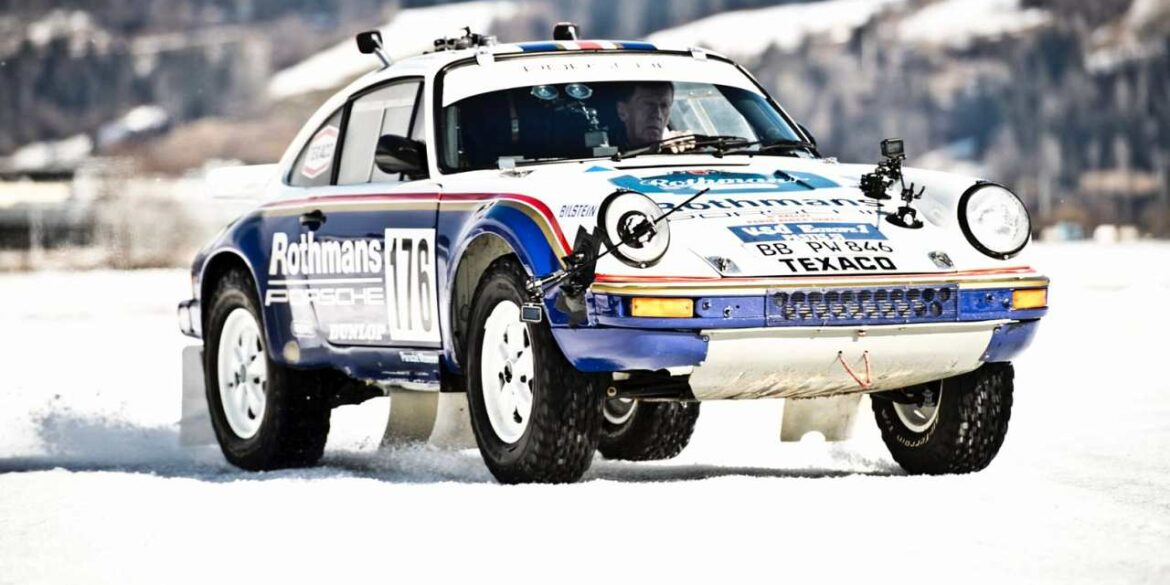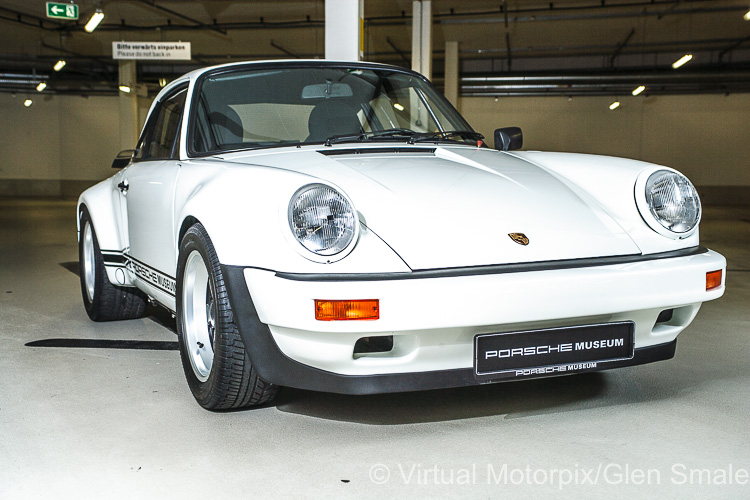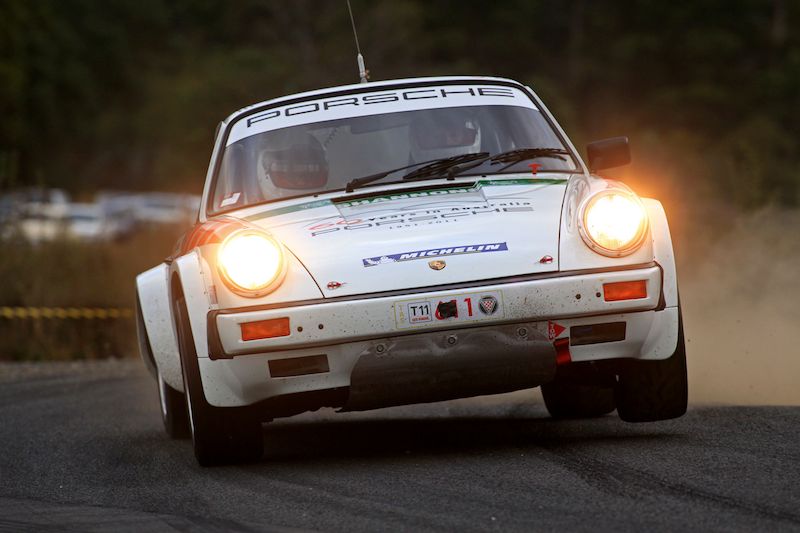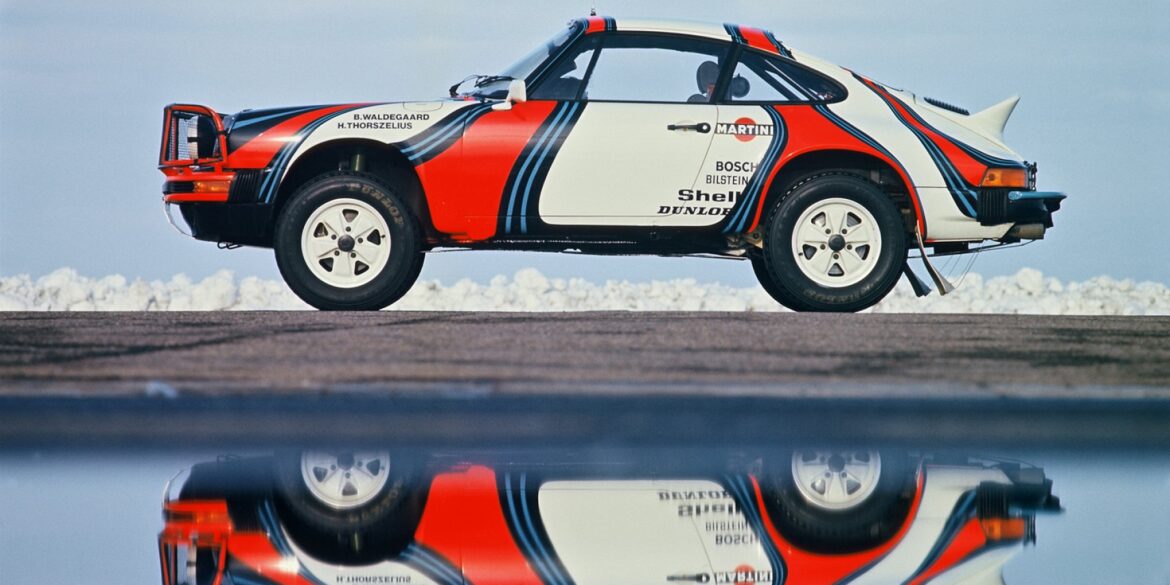The new downsized flat-six gets forced induction, more power and greater efficiency, just like in the basic refreshed 911 Carrera, this time mated to a four-wheel-drive system nicked wholesale from the Turbo. Apparently one in three 911 buyers opt for a four-wheel-drive variant, so this is an important car to get right. The 3.0-liter twin-turbo flat-six in the 911 Carrera 4S is good for 414hp and 368 ft lbs of torque, helping it get from 0 to 62 mph in 4.2 sec with a manual, 4.0 seconds with the PDK and 3.6 sec with the PDK and optional Sport Chrono pack.
The Carrera 4 Cabriolet gets that wonderful extra-wide body and an AWD system hooked up to its new turbocharged 3.0-liter flat-six engine. Additionally, the Carrera 4 Cabriolet gets a spate of new goodies, including a unique taillight section, and an updated infotainment system that brings the sports car’s connectivity to a whole new level. The open top Carrera 4 does a great job as an all-rounder, giving drivers the all-weather assurance of all-wheel drive and combining it with open top driving fun. Dynamically, it is up there with its coupe sibling.
Thought it carries a similar design to the new 911, the Carrera 4 has its own unique features, the most obvious being an AWD system hooked up to its new turbocharged 3.0-liter flat-six engine. The C4 gets a spate of new goodies, including a unique taillight section, and an updated infotainment system that brings the sports car’s connectivity to a whole new level. Inside the new 911 Carrera 4, there are only a few changes, the most important is the new infotainment system. With 370 hp on tap from the direct-injection, twin-turbo flat-six and all-wheel drive putting all those ponies to the ground, the C4 is more than quick enough.
The switch to turbocharging delivers predictably faster acceleration, with 0 - 60 mph taking just 3.9 seconds with the PDK transmission and Sport Chrono optioned. The quarter mile is dispatched in 12.2 seconds and the top speed for the open top Carrera S is 190 mph. These numbers are pretty impressive for an open top 911 that is just as comfortable driving around town as it is on back roads on spirited runs. With the 991.2 Carrera S Cab, it can be argued that there is no real need dynamically to opt for. the coupe body. A great overall sports car that is fast, fun and happens to have no roof.
Porsche purists might moan that the flat-six engine in the rear is no longer naturally aspirated, but with more power and torque, improved efficiency and some advanced interior tech giving this 911 an even bigger breadth of ability than before, this facelifted 991-generation model carries on where the old car left off. Sure, it’s lost a touch of that high rev zing from the old car, but if you add the sports exhaust, the bark from the engine inside and out is still intoxicating. And so is the speed. The 991.2 Carrera S is absolutely amazing on both road and track and still the best sports car around.
To celebrate 60 years of Porsche Club of America, PCNA (Porsche Cars North America) ordered 60 units of 911 Carrera GTS Coupés in Club Blue from Porsche Exclusive. All 60 cars were equipped with SportDesign aerokit (including ducktail). These Club cars were not numbered because it wasn't a special series by Porsche AG, but a series of similarly equipped cars ordered by PCNA. The cars got a few unique touches by Porsche Exclusive, like the special "Club Blau" paint, the "Club Coupe" stickers on the doors, the door entry guards with ''GTS Club Coupe" lettering and number "60" embossed on the armrest cover.
The 2016 Carrera and Boxster Black Editions add some extra niceties for a value-adjusted price. And as the names suggest, both cars come in any color scheme you want so long as it’s, yes, black on black. Or black on black on black in the case of the ragtops. Available in coupe and convertible forms, with rear- or all-wheel drive, each powered by the base 350-hp 3.4-liter flat-6 engine, the 911 Carrera Black Edition adds other design treats too.
The cylinder number and position (six, horizontal) remained the same as before, but the displacement has been reduced to 3.0 liters (from 3.4 liters) and a pair of turbos has been strapped on the engine. And thanks to the force-feeding’s high potential, the same 3.0-liter unit is used for the Carrera S as well (instead of the 3.8-liter flat-six). As a result, the power figures in the Carrera 2 Cabriolet gained 20 hp and some 40 lb-ft of torque vs the prior generation. More importantly, the turbocharging makes the Carrera’s 332 foot-pounds of torque available way quicker, from just 1,700 rpm.
Sticking to their strengths, Porsche has created the most sought after car in its line-up, the 2017 Porsche 911 R. We have seen numerous rumors about this car for a couple of months now and this time we finally get to see it. The new Porsche 911 R with 4-litre naturally aspirated flat-six engine with a six-speed manual gearbox is coming to us for sure. It's lighter and faster with its engines pumping out 493 bhp at 8,250 rpm and 333 lb-ft at 6,250 rpm. The result is probably the best 911 of the modern era. Porsche at its finest.
The 991.2 generation Carrera range update was a big one. The base coupe looks about the same, but under the hood Porsche did something crazy. Gone is the 3.4 liter naturally aspirated flat 6, replaced by a 3.0 turbocharged flat six. The good news is that the new engine is pumps out 370 hp and 331 ft lbs of torque, a big leap over the previous generation (output is up over the previous car by 20 horsepower and 44 lb-ft of torque). Inside, the updated 911 hasn’t changed dramatically, and although Porsche’s new PCM infotainment system is faster and more intuitive to use.
The GT2 was the hardcore, race-focused version of the 993 Turbo, using essentially the same 3.6 L twin-turbocharged engine, but slightly modified with increased power output. The car was made to compete in the FIA GT2 racing class. Among this already very exclusive circle of 57 cars there is an even more rare community. 20 of the 57 road-legal cars were produced in a second – and last – badge with upgraded engine power (450 PS) called GT2 “Clubsport” which make them the last Porsche models with air-cooled engines.
The Porsche 911 GT2 (or GT as it was initially called) from the 993 Porsche series was built in order to meet homologation requirements for the GT2 class racing which had banned all-wheel-drive vehicles by the mid 1990's. As a two-wheel drive vehicle, the GT2 had significant weight savings as compared to the standard 993 Turbo from Porsche, making it instantly competitive in racing. The 993 GT2's original 3.6 L (220 cu in) engine generated a maximum power output of 316 kW (430 PS; 424 hp). There was an update in 1998 that upped power to 450 bhp.
So what else do you get when you buy a 991 Carrera 4 GTS Cabriolet? First of all you get a 30 hp bump over the Carrera 4S to 430 hp from the 3.8L naturally aspirated flat-six. You get forged centre-lock black 20-inch wheels, dynamic engine mounts, the Sports Chrono Package, PASM adaptive damping with a lowered ride height, an interior swathed in Alcantara, a sinister front fascia with black intakes and custom rear apron with black tailpipes that broadcast the goods through an uber-nasty sport exhaust system. Other trim details include black lettering and smoked headlights.
With all-wheel drive and all the GTS goodies, the Carrera 4 GTS sits in a very practical place in the Porsche 911 lineup. The 4 GTS is a Carrera 4S with all the items Porsche thinks you should have at a price that is less than choosing them yourself. Standard equipment on the GTS that is normally optional on the Carrera S includes the Sport Chrono Package, Sport Exhaust, bi-xenon lights with PDLS (Porsche Dynamic Lighting System) and PASM (Porsche Active Suspension Management). Inside, four-way adjustable sport seats are standard.
Like the rest of the GTS lineup, the 991.1 Carrera GTS Cabriolet is essentially a kind of 991 Greatest Hits package, hand-picking some of the more desirable components and options from the 911 range. It gets Porsche's PASM (Porsche Active Suspension Management), Sport Chrono with Sport Plus, the Sport Exhaust system, and a ride height that's roughly four-tenths of an inch lower than non-GTS models. It also gets a version of Porsche's 3.8-liter flat-six with 430 hp, hits 60 mph in 4.0 seconds equipped with the PDK (4.4 to 60 mph for the manual), and tops out at 189 mph.
More aggressive looks, significant extra power, and highly desirable options. This is the perfect all-round 911. In manual, there is nothing that feels as complete. Some of the technical ingredients that generate even more driving dynamics and driving fun: 430 hp (316 kW) power, the Sport Chrono package and the PASM active damper system which lowers the car's ride height by ten millimetres. The extra punch of the 430-hp engine pushes the 911 Carrera GTS coupe up to 190 mph in rear-wheel-drive/manual-transmission configuration, 2 mph higher than the 400-hp Carrera S.
The 993 Carrera RS is a lightweight, stiffer version of the naturally-aspirated 993 Carrera meant for ultimate street performance. At its heart was the 3.8-liter normally aspirated Type M64/20 engine producing 300 bhp at 6,500 rpm along with 262 foot-pounds of torque at 5,400 rpm. Looking to save as much weight as possible, every non-essential item from the car was removed. The Carrera RS tipped the scales at a 1,280 kg. About 1,000 Carrera RS were built, making it one of the rarest and most collectable 993-generation 911's produced. In addition to the Base Trim it was also available as the race-ready, street legal, RS Clubsport (option M003).
The 2012 Carrera 4S Cabriolet had the same wider rear track when compared to the non-S version of the vehicle. It wasn't something everyone would notice, but the difference was there for a reason, and that reason was the wider tires installed. From behind, a rear red light-strip united the LED taillights. Inside the Carrera 4S Cabriolet, there were some luxury features. The leather-covered sport-bucket seats were covered in leather. Even the rear, unusable, seats were wrapped in leather. The center console was higher to give a sense of a single-seat racing roadster.
The new all-wheel drive 911 is being launched on the market in four versions – as the 911 Carrera 4 and 911 Carrera 4S and each as Coupé and Cabriolet. The Coupé and Cabriolet of the 911 Carrera 4 S each have a 3.8-litre rear-mounted boxer engine that produces 400 hp (294 kW); this enables acceleration to 100 km/h in 4.1 seconds (Cabriolet: 4.3 seconds) and a top speed of 299 km/h (Cabriolet: 296 km/h) with a suitable equipment configuration. Fuel consumption values with PDK are 9.1 l/100 km (CO2 215 g/km) for the Coupé and 9.2 l/100 km (CO2 217 g/km) for the Cabriolet.
The new Porsche 911 Carrera 4 unites the excellent performance and efficiency of the new generation of the 911 Carrera with the dynamic benefits of the latest version of the active all-wheel drive system PTM (Porsche Traction Management). The typical Porsche all-wheel drive with rear-focused layout in this latest 911 version guarantees maximum vehicle dynamics on a wide variety of road surfaces and in all weather conditions. The new 911 Carrera 4 models deliver traction and dynamic performance the power of four.
The 2013 Porsche Carrera 4 featured a 3.4-liter flat-six engine. It was mated as standard to a world's first seven-speed manual transmission. An automatic, PDK (dual-clutch) transmission was offered as an option. The Carrera 4 featured an all-wheel-drive torque distribution in the instrument cluster display. The most distinctive identifying feature of the 911 with all-wheel drive is still the wide rear section: compared to the two-wheel drive 911 Carrera models, the rear wheel housings 22 mm wider, and each of the rear tires is 10 mm wider.
The open-top 991 Carrera S Cabriolet requires an $11,600 premium over a comparable coupe; ta not-cheap $108,950 price point for those shopping. For that, you get the best overall open-top sports car around. With the 400-hp, 3.8-liter six and the benefit of the PDK automatic’s launch control, the Carrera S cabriolet should hit 60 mph in 3.8 seconds and cover the quarter-mile in the low 12s. Performance is on-par with the coupe on backroads so any fears that this is a soft-911 are thrown out the window. This is a serious sports car, sans roof.
The 991 Carrera S continued the time honored Porsche 911 tradition of growing in physical size and power. Over the years the 911 has continued its evolution from a pure sports car to a luxurious super-car and the 2012 Carrera S Coupe was no exception. The seventh generation 911 launched in 2012 and it sits on a new platform, with a longer wheelbase and shorter overhangs. It also featured new headlights and taillights. Features a 3.8-liter flat-six engine mated as standard to a world's first seven-speed manual transmission.
Porsche is doubling the driving fun to be had from the new 911 Carrera by putting a Cabriolet alongside the Coupé. The debut of the new generation of the sports car classic is being followed only a few months later by the open-top models of the 911 Carrera and 911 Carrera S in the new 911 design. What the Coupé began with the new aluminium-steel body, the Cabriolet continues with the all-new, unique hood: As a result, the typical 911 roof line is initially retained in its entirety.
The seventh generation 911 was revealed 2011 Frankfurt Motor Show as an all-new model. It sports a longer wheel base, seven-speed gearbox and more efficient 3.4-liter flat-6. Major options include a 7-Speed automatic transmission , dynamic engine mounts and a Sport Chrono Package with a dash mounted analog stopwatch. This package also features a Sport Plus button that changes the settings of the chassis, engine and transmission for spirited driving. Launch Control is also new.
Based on the already primal 997.2 GT3, the RS gets another 15 hp from the 3.8-liter flat-six for a total of 450, or more than 118 hp per liter. A racing machine tamed for street use, the GT3 RS is hardly just about horsepower. It gets a wider track, it weighs less, and it produces more downforce than the GT3. The only available transmission is a six-speed manual gearbox (with the ratios even shorter than the GT3). A racing machine tamed for street use, the GT3 RS also gets a wider track, it weighs less, and it produces more downforce than the GT3.
Even more powerful, faster and more dynamic than ever before, the updated 997 Porsche 911 GT3 (differentiated from the earlier with a new 997.2 designation) is about to prove its enhanced potential. The Porsche 911 GT3 now reaches an even higher standard in its two main qualities: power and driving dynamics. The naturally-aspirated six-cylinder now increased in size to 3.8 litres is 435 bhp (320 kW), up 20 bhp over the previous model. In particular, the flat-six power unit carefully upgraded for even more muscle and performance offers a significant increase in torque at medium engine speeds. Road performance is spectacular.
The 997 Sport Classic is a limited edition version of the 997.2 Carrera S coupé inspired by the 1973 Carrera RS 2.7. The engine is rated at 413 PS (304 kW; 407 hp) and features a newly developed resonance intake manifold with 6 vacuum-controlled switching flaps. It includes a 6-speed manual transmission, double-dome roof (informally called double bubble roof), 44 mm (1.7 in) wider rear fenders, SportDesign front apron with a front spoiler and a fixed 'duck tail' rear wing. Only 256 were made.
Porsche faithful are probably shaking their heads right about now. Porsche never officially made a production 993 Speedster. Notice we said “production.” In 1995, the company created a dark green 993 Speedster for Ferdinand “Butzi” Porsche 60th birthday. Jerry Seinfeld apparently felt left out; he commissioned a silver 993 Speedster in 1998, though it seemed to have begun life as either a Targa or Cabriolet before being sent to Porsche Exclusive. Only two 993 Speedsters were ever made; if you see one that’s not silver or dark green, chances are it’s a phony. The rarest among these models is the 911 Speedster.
The 997 911 GT3 RS is an even lighter and more purist version of the 911 than the regular GT3. 20 kilograms lighter than the GT3 and equipped with a close-ratio six speed manual the GT3 RS gets to 60 mph 1/10th of a second faster than the GT3. The 911 GT3 RS is 44mm wider at the rear than the GT3. The wider track helps improve directional stability when cornering. Weight savings can be found throughout the car. The Clubsport version there is a bolted roll cage, a six-point harness for the driver and a built in fire extinguisher.
If the 996.1 911 GT3 was all about the engine, in the 997.1 completes the rest of the formula. The surgical clarity of its transmission, steering, brakes, pedal weights and heights, and overall chassis balance represented a clear step-change from its regular 997 911 siblings. But the engine was still the heart of the car, the water-cooled 3.6-liter flat-six boasting a new intake and a new exhaust compared with the 996 versions. Official output was 415 hp, though insiders admit some engines made close to 430 hp. Launched in 2006, today this is in many ways the sweet-spot GT3, way more affordable than the later 4.0.
In recognition of the 50th Anniversary of the Porsche Club of America (PCA), Porsche has created an exclusive 911 Carrera' S Coupe model featuring a distinctive exterior color, unique interior styling and commemorative touches, and a more powerful and higher performing engine. Limited to an exclusive production run of just 50 cars initially made available to eligible PCA members, the 911 Club Coupe was unveiled this past weekend at PCA's 50th Annual Porsche Parade in Hershey, Pa.
The Porsche 911 Turbo Cabriolet (993 generation) is an incredibly rare car – only 14 were built in 1995, in the early days of 993 production. Rather than the contemporary twin-turbo powerplant in the 993 Turbo Coupe, the 993 Turbo Cab was fitted with the single turbo of the 964 Turbo 3.6. Although the Turbo Coupé was introduced earlier, the actual production started after the Turbo Cabriolets were sold. Turbo Cabriolets were 1995 models by VIN and Turbo Coupés were immediately produced as 1996 models although the 1996 model year had not yet started.
The 997.2 Turbo was introduced for the 2010 model year and received a new 3.8 litre engine capable of 493 horsepower, a significant evolution as compared to the 473hp in the 997.1 Turbo. The 997.2 Turbo was available in both manual and automatic transmissions, but the automatic evolved from the Tiptronic used in its predecessor, to a sportier dual-clutch PDK. Approximately 3,300 coupes were produced and 1,800 cabrios, far less than its predecessor. An epic all-around GT with more performance than you could ever need.
The 997.2 Turbo was introduced for the 2010 model year and received a new 3.8 litre engine capable of 493 horsepower, a significant evolution as compared to the 473hp in the 997.1 Turbo. The 997.2 Turbo was available in both manual and automatic transmissions, but the automatic evolved from the Tiptronic used in its predecessor, to a sportier dual-clutch PDK. Approximately 3,300 coupes were produced and 1,800 cabrios, far less than its predecessor. An epic all-around GT with more performance than you could ever need.
As with the previous 996 Targa model, the most striking feature of the car is the large, sliding-glass roof and glass rear hatch, which blend sleekly into the classic 911 lines while providing the Targa with its own unique personality. Like the rest of the range the Targa 4S got a visual refresh and the all-new direct injection engine. In the Targa 4S, it produced 380 bhp @ 6500 rpm and torque of 310 ft lbs @ 4400 rpm. 0 - 60 mph takes just 4.5 seconds (PDK) and top speed is 185 mph.
The 911 Targa received the same upgrades during the switchover to the 997.2 generation, including a boost in power and performance. The expansive glass roof now featured increased UV protection. This is the point in Porsche 911 Targa history when the model re-established itself as the perfect halfway measure between a true coupe and a convertible. Porsche engineered a wildly complex power-retracting center roof piece and left the rear glass fixed in place. Beyond this fabulous roof mechanism, it’s the same Carrera 4.
In the case of the 911 Carrera 4S Cabriolet that begins with a larger, more potent six-cylinder engine. The Carrera 4S is powered by a 3.8-liter flat six that produces 355 horsepower and 295 lb.-ft. of torque. The roughly ten percent increase in power translates to improved acceleration and higher top track speed. The 911 Carrera 4S Cabriolet with the six-speed manual gearbox races from a stop to 60 mph in only 4.7 seconds, topping out at the track at 185 mph. When carrying the optional Tiptronic S transmission, the zero to 60 mph sprint takes a mere 4.5 seconds.
For 2009, engine power is distributed to all four wheels via the same electronically controlled Porsche Traction Management system found previously only on the Porsche Turbo. The electronic controls respond to driving conditions even more instantaneously than the previously used hydraulically activated all-wheel drive system. The Carrera 4S model, with a 3.8-litre engine developing 355 bhp, can go from 0 to 60 mph in 4.5 seconds and has a top speed of 185 mph.
The 2009 Porsche 911 Carrera 4 Cabriolet shares the same internal 997 model designation as its Coupe siblings. It also shares the same essential all-wheel-drive architecture, interior appointments, suspensions and drivetrains. It is an open-top sports cars that deliver the same exhilarating acceleration and dynamic response as the coupes, regardless of weather or road conditions. The Carrera 4 Cabriolet boast a unique body over their all-wheel-drive powertrains with a wide-body design.
Most importantly, the refreshed Carrera 4 and 4S lose the old multi-plate, viscous all-wheel-drive system in favor of the electronically controlled system from the 911 Turbo. The old system could send between 5 and 40 percent of engine torque to the front wheels once it had detected wheelspin. The new electronic system can anticipate traction losses and shift up to 100 percent of engine torque fore or aft. Porsche says the new AWD system reacts faster to traction changes, and doesn’t make the Carrera 4 significantly heavier.
Like the rest of the range the Carrera S Cabriolet got a new 997.2 generation update. Not much is new on the outside, but the design refresh did give it a revised front bumper and larger air intakes, as well as by new large mirrors and the bright strip of LEDs below the headlights that serve as daytime running lights. Inside the car, there's a new communication management system, PCM 3.0 which includes a new touchscreen feature, is standard on all 2009 and onward 911s.
For the 997.2 generation, power from the 3.6-liter Carrera engine was increased to 345 hp while the Carrera S saw 385 horsepower from its 3.8-liter flat-six. Power was sent to the rear wheels via a standard manual box but for the first time, the 997.2 saw the introduction of the dual-clutch PDK as an option. The chassis remains largely unchanged, with slightly modified springs and dampers. The sports suspension is replaced with a variable, electronically controlled sports suspension based on the active PASM suspension. The sweet spot in the used car market at the moment.
The 911 Carrera Cabriolet is a true Porsche, from top to bottom. Like the rest of the range, the base Cabriolet got a mild refresh in terms of design that made it more modern and a little more crisp. The engine was upgraded, now with direct direction. The direct-injection 3.6-liter engine also got new air filters, a more free-flowing exhaust system, and reduced engine friction, making it more powerful than before. It has peak power of 339 bhp @ 6500 rpm and torque of 287 ft lbs @ 4400 rpm. The Carrera equipped with PDK covers 0-60 mph in 4.5 seconds and runs to a top speed of 179 mph.
Porsche refers to it as a new generation, even though the internal chassis code 997 remains unchanged. The 997.2 therefore is more of a mid-term facelift with some significant technological changes. Notably, the water-cooled flat-six engines get direct-injection technology, and a seven-speed, dual-clutch transmission replaces the previous five-speed Tiptronic automatic while the shift-it-yourself option remains a six-speed. Base Carrera coupe gets 339 bhp and 287 ft lbs and a 0.3 second faster 0 - 60 mph time of 4.5 seconds. Top speed now 179 mph. A nice update indeed.
The Type 964 911 first launch with an all wheel drive model. It was a serious investment by Porsche in updating the chassis and tech platform. The 964 Carrera 4 was powered by the M64/01 3.6 liter flat six engine, developing 250 bhp and 229 ft/lbs of torque. The objective of the C4’s all-wheel-drive system was not only to provide improved traction but also better handling, especially in the wet and on slippery surfaces. The system sends power front/back in a 31:69 ratio because a 50:50 split would have made the 964 feel like a front-wheel-drive car.
Like the 911 Turbo Coupe, the 997 Turbo Cabriolet is powered by a 3.6 liter six-cylinder boxer engine with biturbo turbocharging and Variable Turbine Geometry (VTG). The powerplant already generates 480 hp (473 bhp) and 460 ft lbs of torque at 1950 rpm. The manual transmission version can accelerate from 0 to 100 km/h in just four seconds while the Tiptronic S the time can be cut to 3.6 seconds. Top speed for the Cab is the same 193 mph as Coupe and only weighs 70 kilos.
The two 997 Targa 4 cars are both offered in only all-wheel-drive. Available with either a 3.6 litre flat 6 in the Targa 4, or with a more powerful 3.8 litre flat 6 in the Targa 4S, the new car offers almost all the fun of a convertible without sacrificing the dynamic abilities of a hardtop. The Targa 4S gets to 60 mph in 4.7 seconds and tops out at 179 mph thanks to its 3.8 liter flat six pumping out 350 bhp and 295 ft lbs of torque. It has softer spring rates than the coupe, a more generous helping of leather in the cabin, a better tally of standard equipment, more storage space behind the front seats.
The 997 Targa design is the same as the 996s, with the power-operated panoramic sunroof and lifting rear window glass. The 997 Targa version's entire operation benefitted from thinner glass that cut approximately 4.2 pounds from its weight relative to the prior 996-series Targa. The 997 Targa 4 has softer spring rates than the coupe, a more generous helping of leather in the cabin, a better tally of standard equipment. The Targa 4 might therefore be all the 911 you ever want; not the fastest or the most visceral, but certainly the most complete car in a very impressive bunch. A great all-rounder.
The sixth generation of the 911 series’ top-of-the-range model was unveiled at the 2006 Geneva Motor Show. The 997 911 Turbo has 473 bhp @ 6000 rpm, 60 bhp more than its predecessor. Rated torque is now 473 bhp @ 6000 rpm. The speed range in which this power is available has also been extended. While the previous model’s maximum torque was available between 2,700 and 4,600 revolutions per minute, the corresponding figures are now 1,950 to 5,000 revs. 0 to 60 mph is over in a blistering 3.6 seconds and top speed is 193 mph. The ultimate GT.
While the 997 Carrera 4S coupe sold a healthy 15,056 units between 2006 and 2008, the equally exciting Carrera 4S Cabriolet sold 12,587 units, making it a pretty popular 997 model. The reason is pretty simple. It had a gorgeous wide-body stance, all-wheel drive traction and that potent 3.8 L Flat 6 that was good for 350 bhp and 295 ft lbs of torque. The first convertible 911 that was as good a performer as it coupe siblings with the added benefit of open top driving in the summer with the comfort of being a great daily driver all year round.
Along with its sibling Carrera 4, the 2005 Carrera 4S offered an all-wheel-drive system for the Porsche 911, but unlike the 4, the 4S gets the Carrera S' more powerful engine and it turns out that makes a big difference. The Carrera 4S was the more powerful and more dynamic version of the 997 Carrera 4 and an overall great sports car, especially for those in colder climates who need the safety of all-wheel traction. All rounder that fits nicely in the 911 lineup as perhaps the most practical.
The Carrera 4 Cabriolet was released with the rest of the 4 and 4S models as 2006 model year cars. With a sure-footed, four-wheel drive powertrain as well as that "wide-body" stance, and with tops that open or close at the touch of a button, the Carrera 4 Cabriolet really started to make the case it could do it all. The wide look gave the 4 a widened track, larger wheels and tires and four-wheel-drive powertrain that gives more dynamic stability, especially in inclement weather conditions. Developed at the same time as the coupe.
The 997 Carrera 4 was the all-wheel-drive version of the standard 997 Carrera and it arrived as a 2006 model year car (along with the 4S models). The 997.1 Carrera 4 had a3.6 L Watercooled Flat 6 (M96/05) engine that was good for 321 bhp @ 6800 rpm and 273 ft lbs @ 4250 rpm. It had a sub 5 second 0 - 60 mph hour time and a top speed of 174 mph. The transmission (six-speed manual or five-speed Tiptronic) feeds a forward propshaft that mates to a viscous coupling unit with a front differential.
The Carrera S convertible was introduced to the market at the same time with the Carrera Cabriolet, a few months after their coupe-versions were unveiled. The convertible version for the Carrera S got reinforcements needed for the cabriolet built while the engineering was going on for the coupe, ensuring that the drop-top version was just as strong and performance-focused. It got the same engine as the Carrera S and made a case for itself as the best 911 of the range at the time.
The 997 Carrera S was the first step up in performance over the base 997 Carrera. Available over two distinct generations, the 997.1 Carrera S used a 3.8-liter engine producing 355hp – the available X51 Powerkit bumped that number to 376hp. From 2009 onwards, the 997.2 Carrera S offered 380hp from 3.8 liters. Besides a more powerful engine, it also comes standard with 19 inch wheels, larger brakes, and a lowered suspension with PASM.
Just a few months after the introduction of the 2004 911 (997 series), the convertible version was released. The release of the 997 911 Carrera Cabriolet marked the first time since 1977 that Porsche has given the convertible 911s the same engines as their Coupe siblings. The base 997 Carrera Cabriolet gets the 3.6-liter flat six-cylinder engine with 321 bhp and 273 ft lbs of torque. The convertible version for both Carrera and Carrera S was developed at the same time with the coupe.
The base Carrera has essentially the same 3.6 L flat-6 engine that its predecessor, the Type 996 Carrera used, now good for 321 bhp @ 6800 rpm and with torque of 273 ft lbs @ 4250 rpm. The sprint from 0 to 60 mph is over in just 4.80 seconds and top speed is 177 mph. The quarter mile is over in a respectable 13.1 seconds. The 911 Carrera is now faster, more stable, more precise and forgiving, an altogether superior-make that more efficient-sports car than the 996.
2,500 cabriolets were made in the 993 Carrera 4. The 993 Carrera 4, sold between 1995 and 1998, uses the same powerplant as the standard 993 Carrera, but puts power down to all four wheels through a 6-speed manual transmission. A “Carrera 4” badge on the tail, along with silver-painted brake calipers and clear front and side turn signals, help distinguish the all-wheel drive C4 from the C2 sibling.
The 993 Carrera 4, sold between 1995 and 1998, uses the same powerplant as the standard 993 Carrera, but puts power down to all four wheels through a 6-speed manual transmission. A “Carrera 4” badge on the tail, along with silver-painted brake calipers and clear front and side turn signals, help distinguish the all-wheel drive C4 from the C2 sibling. Approximately 4,700 coupes and 2,500 cabriolets were made. It was replaced by the Porsche 911 Carrera 4 (996 generation) in 1999.
Introduced in 1994 the Porsche 911 Cabriolet was more of a Grand Tourismo vehicle than a sports car. The 911 Cabrio featured the same cues as its coupe version, but with a few differences apart from the lack of a fixed roof, of course. The 3.6-liter engine was offered in two versions, with 275 hp and 285 hp. The latter featured the VarioCam system. Both versions were mated to either a 6-speed manual or a 4-speed automatic.
Introduced in late 1994 the standard 911 Carrera of the 993 generation was fitted with a development of the M64 3.6-liter flat six that had been found in the prior 964 generation. With a redesigned exhaust system and new hydraulic lifters, the engine produced 272 horsepower. For the 1996 model year, a Targa variant was introduced, and a variable intake runner system (called VarioRam) was added to the entire Carrera lineup, bumping horsepower to 285. Approximately 23,000 coupes were built, 15,500 cabriolets, and 4,500 Targa's, in both manual and automatic (Tiptronic) transmission. Overlapping with the last year of production, it was replaced by the 911 Carrera of the 996 generation for model year 1998.
For those who want more extreme performance, handling and track-day bragging rights, the RS is it. It's far from practical and may be too extreme for some, especially on the street, but on track it is exceptional. Only marginally quicker than the 991 GT3 that it is based on, but it delivers that performance with a different character. Massive grip, massive downforce and more extreme than the GT3. It delivers 80 per cent of the downforce of the full-on GT3 R race car, and with a carbon fibre bonnet and wings, a magnesium roof and polycarbonate rear windows and screen, it’s also light, weighing in at just 1,420kg.
Porsche introduced the 991 GT3 for the 2014 model year, as follow up to the multiple 997 GT3 variants. The 991 GT3 featured a new 3.8 litre direct fuel injection (DFI) flat-six engine developing 475 hp (354 kW; 482 PS) at 8,250 rpm, Porsche's Doppelkupplung (PDK) double-clutch gearbox, and rear-wheel steering. The 911 GT3 is claimed to be able to accelerate from 0-60 mph (97 km/h) in 3.1 seconds or less, and the quarter mile in 11.2 seconds at 126 mph (203 km/h). It evolved into the 991.2 GT3 for model year 2018.
The 2014 50th Anniversary Edition 911 was built by Porsche to commemorate the 911’s birthday, 50 years after its production launch in 1964. In homage to 1963, the year the 911 debuted at the 1963 Frankfurt Motor Show, production was limited to 1,963 units. The 50th Anniversary uses the wider body from a Carrera 4S (but remains only rear-wheel-drive) and is lower than a standard Carrera by 10mm. The 20 inch-alloys are a modern take on the original Fuchs wheels, and the seats are finished in “Pepita” cloth. Includes Porsche Active Suspension Management (PASM), sports exhaust and powerkit tickled 430 hp flat six.
The 996 Cabriolet was introduced in March 1998 at the Geneva Motor Show. The 996 Cabriolet was long ready (remember, it was tested already in 1995), but for marketing and production-related reasons it was launched in 1998 as a 1999 model. While the evolution with the 911 coupe was questionable from 993 to 996, the real evolution came with the cabriolet. In USA - the biggest market - 911 Cabriolets outsold the Coupés. The all-wheel-drive system provides between 5-40% of torque to the front wheels depending on the situation.
Since 1989, the rear-wheel-drive Carrera has always been accompanied by an all-wheel-drive Carrera 4, and the 996 was no different. Overlapping with the last year Carrera 993'S, the 996 Carrera 4 represented two major changes for the venerable 911 lineage: a water-cooled flat-6 engine replaced the air-cooled engine used in the previous 911 model, and the body shell received its first major re-design. Engine was 3.4 L and power was 296 hp featuring a change to an "integrated dry sump" design and variable valve timing.
The flat six in the Carrera 996 was a newly-developed flat-six engine that offered 300 hp. It was mated as standard with a six-speed manual. A 5-speed automatic (Tiptronic) with manual override to shift gears was on the options list. As always, the Carrera 2 was rear-wheel-drive. Designed as a grand tourer, the Porsche Carrera Cabriolet was the base version for the open-top 911 range in 1998. The retractable roof was able to be stowed away in 20 seconds at speeds of up to 50 kph (31 mph), like the rest of the 911 convertible range. With the roof up, the car was tested in the wind tunnel at speeds of up to 338 kph (210 mph).
The 996 series was a monumental update to the 911 story. The Type 996 introduced water-cooled engines and it also ushered in a new body design. The roof line with a windscreen which is around five degrees flatter gives the side view a more fluid look. Gone was the "classic" 911 design, the entire main body now much sleeker. The flat six in the Carrera 996 was a newly-developed flat-six engine that offered 300 hp. It was mated as standard with a six-speed manual. A 5-speed automatic (Tiptronic) with manual override to shift gears was on the options list. As always, the Carrera 2 was rear-wheel-drive.
The 1998 GT1 car was a totally rethink and vast upgrade versus the prior year car. 1998 Le Mans 24-hour race In the 1998 jubilee year, the Porsche team celebrated its 16th overall victory in Le Mans with a double win for the 911 GT1 98. On 6th/7th June, the winning car was driven by Laurent Aiello, Allan McNish and Stéphane Ortelli. It was almost 50 years to the day on which the first Porsche sports car saw the light of day.
Towards the end of the 1996 season, Porsche made revisions to the 911 GT1 in preparation for the 1997 season. The front end of the car was revised including new bodywork which featured headlamps that previewed the all-new generation of the (996) Porsche 911 which would be unveiled in 1997. It had the same engine as the previous version, but new aerodynamic elements allowed the 1997 version to be considerably faster than the 1996 version. At Le Mans the works cars led the race but did not last the full distance; a privately entered 1996 specification GT1 managed 5th overall and third in its class.
In spite of its 911 moniker, the car actually had very little in common with the 911 of the time, only sharing the front and rear headlamps with the production sports car. Designed and developed to compete in the GT1 class of sportscar racing, which also required a street-legal version for homologation purposes. It was powered by a twin-turbo flat 6 that was good for 600 bhp. The 1996 911 GT1 clocked at a top speed of exactly 330 km/h (205 mph) on the legendary Mulsanne Straight.
The 993 Carrera Cup 3.8 was developed from the 993 Carrera RS, as purpose-built competition car designed by Porsche for its single-model racing series taking place around the world. Replacing the 964 Carrera Cup, the 993 Carrera Cup had a claimed 315 bhp on tap, weighed only 1,100kg, and offered a top speed of around 270km/h (170mph). Approximately 216 samples were built. The Carrera Cup should not be confused witth the Carrera RSR, or the 993 Carrera RS Clubsport version.
With the 1993 Carrera 2 as the starting point, Porsche had to make at least 50 roadgoing cars in order to qualify this new model for the Carrera ADAC GT Cup, which served as the basis for a motor racing variant to come, the Carrera RSR 3.8. The RSR 3.8 was nothing short of an all-out race car that could be delivered to the track in a ‘just add driver’ form. The Porsche Carrera RSR 3.8 racked up a catalogue of impressive international race results right from the outset, winning overall at the Spa 24 Hours, Suzuka 1000km, and the 24 Hours of Interlagos.
For race teams and track day customers Porsche prepared a small number of the 964 Cup cars according to the FIA NG-T regulations. Officially called the Competition model, these custom-ordered cars were an intermediary step between the Carrera Cup option (M001) and the standard tourer (M002). This M0003 option was available directly from Porsche as a road-going model. These cars had almost all the Carrera Cup modifications including the new suspension. This lowered the car by 40mm in the rear and 50mm in the front. It also included fitting of the larger 930 Turbo disc brakes and adjustable anti-roll bars.
Introduced in 1989 (the year of the 911’s 25th anniversary), the 964 Carrera 4 was a significant new model for the company, but the 4-wheel drive system was deemed unsuitable for the company’s racing series. Manufactured alongside the Carrera 4 at the same time was the more traditional rear-wheel drive Carrera 2, but this model’s launch was only planned for a year later, in the hope that it would not detract from potential sales of the Carrera 4. The 1990 season was the first season that saw the 911-based model become the pillar on which the Porsche Carrera Cup series has been established.
The Porsche 953 ranks as one of the finest off-roaders Porsche has ever made. It was basically a souped-up 911 designed specially to give Porsche an advantage in the 1984 Paris–Dakar Rally. Just a year later, it was replaced by the 959. Despite its brief run, it still managed to make quite the impression. Built around a massively enhanced suspension and a supremely powerful 300 bhp (224 kW), 6-cylinder engine, it showed Porsche knew more than just sportscars.
Built so that the factory Rothmans Porsche Rally Team could hit the international stage, the SC RS used the Turbo’s body with fibreglass bumpers and aluminium doors. In Autumn 1983, Porsche presents the 911 SC/RS for motor racing. The engine originates from the 911 SC, with improved performance achieved by the mechanical ball fuel injection, increased compression, the cylinder heads from the 935 and forged pistons. Racing seats are fitted in place of the standard seats.
Röhrl and Geistdörfer very nearly won that San Remo Rally, after a comeback that would have been one for the ages. Röhrl and Geistdörfer were up against a field of faster, more powerful four-wheel-drive cars in their rear-wheel-drive Porsche 911 SC, and somehow managed to pull within an eyelash of victory. Unfortunately, a broken driveshaft forced the pair to retire, leaving Michele Mouton's Audi Quattro to run away with the race.
In 1978, the works team fields two 911 SC at the East African Safari Rally. The name of game is to survive 5,000 kilometres of the toughest tracks in sweltering heat and torrential rain. The conditions take their toll: of the 72 starters, 13 reach the finish line. Martini Racing Porsche System Engineering signs on two specialists to drive: Sweden’s Björn Waldegård (Start No. 5) and Kenyan Vic Preston Jnr (Start No. 14).
No More Content


